new posts in all blogs
Viewing: Blog Posts Tagged with: Tips, Most Recent at Top [Help]
Results 51 - 75 of 379
How to use this Page
You are viewing the most recent posts tagged with the words: Tips in the JacketFlap blog reader. What is a tag? Think of a tag as a keyword or category label. Tags can both help you find posts on JacketFlap.com as well as provide an easy way for you to "remember" and classify posts for later recall. Try adding a tag yourself by clicking "Add a tag" below a post's header. Scroll down through the list of Recent Posts in the left column and click on a post title that sounds interesting. You can view all posts from a specific blog by clicking the Blog name in the right column, or you can click a 'More Posts from this Blog' link in any individual post.

By: Kathy Temean,
on 8/11/2014
Blog:
Writing and Illustrating
(
Login to Add to MyJacketFlap)
JacketFlap tags:
Tips,
inspiration,
Advice,
Process,
article,
Critique Partners,
Writing and Illustrating,
Erika Wassall,
Jersey Farm Scribe,
Matchmaking for Writers,
Add a tag
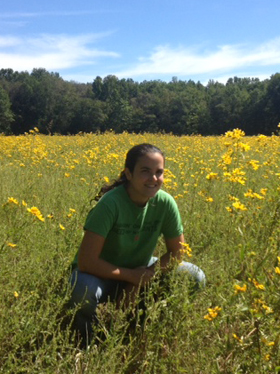 Jersey Farm Scribe here on:
Jersey Farm Scribe here on:
Matchmaking for Writers: Critique Partners
It’s your baby, your pride and joy. It’s put you through countless cups of coffee, frustration and tears, drizzled with moments of incomparable joy when things just click. Fingernails have been shredded, dishes have piled up, and sleep?? You’ve basically forgotten what that is.
And now you’re supposed to let someone else actually READ it????
AND CRITIQUE IT???
But what if they don’t understand?? They don’t know the characters like I do!! How can I just hand it over to someone else, basically for the sole purpose of being criticized?
What am I? A masochist?
You want the honest answer? It’s simple. The answer is: Yes. Yes, you are. J
Here you are, actively seeking someone who will point out the flaws in your work… the more the better. And it’s going to hurt.
But you don’t want people to just tell you they loved it and what a great writer you are. Well… you do (or at least I certainly do! Sometimes I just need that motivator, that lift, that person that makes me feel good about my work, and myself). But that’s what your friends and family are for! If you do happen to be friends with your critique partners, you need to separate that friendship from the critique process.
It’s incredibly nerve-wracking to hand your manuscript to someone else. And it’s exciting at the same time. This means you have something complete enough for someone to actually read! Go you!! Now you have to be brave enough to let them.
Finding the Right Partners
There is a balance in a good critique partner that just fits. And like most relationships, it’s almost hard to put into words. (Unfortunately there is no eHarmony for us!) Finding the right person or people makes all the difference in what you get out of the process.
Here are a few things I look for:
Praise and critique combo: Everyone has a balance here. Rarely will you find someone who would just say “this stinks”. Most people will balance negatives will some level of positive. But personally, I want someone who isn’t afraid to tell me about major holes or plot arcs that they don’t think work, even if it means a huge re-write. But, for that ego side of me, I also need someone who can also point out a think or two that they DO like, and even better, WHY they like it. This also helps me see my own strengths so I can guide my writing in that direction in the future.
Relative Match in Style: While I don’t think the genres need to match, there does need to be some common ground. Someone who writes zombie thrillers may not be on the same page as a picture book author. Personal beliefs can come into play here as well. Some people believe strongly in books that push boundaries, others in the value of simplicity and comfort more within those same boundaries. Certainly neither person is right or wrong, but the two would probably not make good critique partners.
They GET Your Writing: You don’t want someone who is going to push you to be anyone other than the true writer inside you, so you need them to appreciates your voice. If your voice as a writer comes through as an edgy, jaded teenager from a broken home, and your critique partner only likes upbeat, bubbly writing, they’re going to want your writing to be less… you. No one can (or should) please everyone. No writing voice pleases everyone either. You need someone who will encourage the voice inside you to come out.
You Love THEIR Writing: Critique partners is often set up as an exchange. My critique partners are people whose writing I highly respect, I enjoy reading their work, and I learn from their writing. You want someone who you can build a mutual relationship with over time, sharing the ups and downs and exchanging motivation.
Good Communication: Are you looking for just a few comments? Line edits? Overall thoughts? At different stages in the process you may be in need of completely different types of critiques. For example, if you’re submitting to an agent in two days, you may be looking for typos, simple fixes, odd word usage, but NOT major character or plot changes. You need to be able to trust that you can communicate that to them without a problem.
Good critique partners are worth their weight in GOLD. I have been so lucky to have found a few who are amazing, and it really is hard to put into words. Their feedback has been helpful, not just for that particular manuscript, but has given me perspective on my writing that flows forward into all my work.
And as I’ve said before, like Kathy said to me the first time she gave me a critique. critiques are SUGGESTIONS NOT INSTRUCTIONS. It’s important to be open-minded, and put serious non-biased consideration (at least as non-biased as possible) into every one. But don’t feel pressured to take them all. A good critique partner will also never be offended if you didn’t take their suggestions.
Critiques are an important part in the journey of writing and publication. It may take a few tries to find the partners that work best for you. But it’s important to keep looking, because good critique partners can really help you bring your manuscript, and your writing in general, to the next level.
So take the plunge, send work out to be read by others, and find the critique partners that work for you.
Because your manuscripts are worth it!
Thank you Erika for another super article. I am sure everyone will enjoy reading this.
If you are looking for a critique group, you should look first to your local SCBWI Chapter. They should be able to set you on the right path. Plus, don’t forget you can find other writers from around the country to work with online.
Talk tomorrow,
Kathy
Filed under:
Advice,
article,
inspiration,
Process,
Tips Tagged:
Critique Partners,
Erika Wassall,
Jersey Farm Scribe,
Matchmaking for Writers,
Writing and Illustrating 


By: Kathy Temean,
on 8/9/2014
Blog:
Writing and Illustrating
(
Login to Add to MyJacketFlap)
JacketFlap tags:
Tips,
list,
Advice,
article,
Social Media,
authors and illustrators,
opportunity,
Carly Watters,
7 Ways to Make Yourself an Easy Author to Work with,
Agent,
Add a tag
 A few weeks ago, Agent Carly Watters on her blog talked about after you write a great manuscript, how does an agent decide to work with someone after that? She has seven tips.
A few weeks ago, Agent Carly Watters on her blog talked about after you write a great manuscript, how does an agent decide to work with someone after that? She has seven tips.
7 Ways To Make Yourself An Easy Author to Work With by Carly Watters:
1. Open to revisions
Right away, I know if an author is going to be a fit for me based on how they react to revision ideas. Agents are looking for writers that are open to feedback and collaboration. If I gave you an R&R did you connect with my notes? Did you ask questions that take my notes from suggestions to big picture changes that make the novel better?
2. Always wants to get better
A line I like to use is “trust your future self.” What that means to me is if you can write good novel, you can write many more. Getting defensive about your novel means you are holding on to it when really you should be willing to let it go and work on the next. Agents are looking to represent authors for the long term, so what we need is the faith that you want to be the best writer, every time you write a new book. We know there will be ups and downs, but it’s that drive to succeed that will separate many writers from the ones that don’t make it.
3. Treats assistants and senior industry members alike
From time to time we get people who respond to our query letter auto-response with condescending and mean emails. It doesn’t matter who is on the other end of those emails, our principal agent or our assistant, you have to be friendly to everyone–not just the people who influence your career. Those mean emails just reinforce our decision to pass without a second thought.
4. Asks questions
I love it when authors want to know more about the process. Don’t be shy about wanting to know how the business works. Whether it’s a Twitter #askagent session or when you’re on ‘The Call’ with an agent, make sure you ask the important questions that help your understanding.
5. Trusts us
The number one way to work with an agent for a long period of time is trust. I know this isn’t built over night, but you have to trust your agent to have your best interests at heart. This is one of the most important long-term author/agent relationship requirements. Only query agents that you see yourself working with and that you already trust (whether it’s a referral, their taste or client list).
6. Communication
This is part of trust, but authors have to be up-front with agents. Did you self publish before? Have you had an agent before? Can you share your sales numbers from your previous book? It’s the little things that add up when it comes to communication. We need to know everything if we’re going to represent you well.
7. Professional on social media
As easy as it is for authors to Google agents to see if we might be a fit for you, when we fall in love with a query or manuscript the first thing we do is Google you back. What agents love to see on social media is a personality (not just link blasts). You don’t have to have a ton of followers (but points if you do!) to get our attention. It’s all about the balance between promotion and personality. We love it when authors are part of writing communities and support other authors. That means, when the time comes, those other published writers will support you too.
You should check out Carly’s Blog: http://carlywatters.com/blog/
PS Literary is looking for an intern. Carly has information about working remotely for them. If you have any aspirations to become a literary Agent, this would be something to consider.
Talk tomorrow,
Kathy
Filed under:
Advice,
Agent,
article,
authors and illustrators,
list,
opportunity,
Social Media,
Tips Tagged:
7 Ways to Make Yourself an Easy Author to Work with,
Carly Watters 


By: Kathy Temean,
on 8/6/2014
Blog:
Writing and Illustrating
(
Login to Add to MyJacketFlap)
JacketFlap tags:
Tips,
reference,
Advice,
Amazon Reviews,
How to,
need to know,
Marketing a book,
Advanced Reader Copy,
Amazon Ebook Price Reduction,
Add a tag

- Give out a ARC to people who have a large following on their blogs, but ask them to commit to reading your book and doing a review. Need to work on this months before your book is released. Remember the more reviews you get the better your book will do, but they need to be good reviews.
- For the people who you gave an ARC to, ask them to pass on the book to another person to read to expand your audience.
- Ask everyone who does a review on Amazon to also put it up on Goodreads, too.
- If you have an ebook, consider having Amazon offer it on their Deal of the Day. Reducing the price for a few days or a week, will boost your sales and start word of mouth.
- Have family/friends/colleagues/fans buy your book during a ‘soft’ launch (pre-advertising, or promoting your book on social media).
- Price your book at 99 cents (the lowest allowed by Amazon) and drive as much traffic as you can during your ‘soft’ launch window. Once you have the bar filled you can re-price your book.
Talk tomorrow,
Kathy
Filed under:
Advice,
How to,
Marketing a book,
need to know,
reference,
Tips Tagged:
Advanced Reader Copy,
Amazon Ebook Price Reduction,
Amazon Reviews 


By: Kathy Temean,
on 8/5/2014
Blog:
Writing and Illustrating
(
Login to Add to MyJacketFlap)
JacketFlap tags:
Tips,
list,
Book,
Advice,
authors and illustrators,
Publishing Industry,
Pandemic,
Marketing a book,
Yvonne Ventresca,
Amazon Sales Page,
Maximize Book Sales,
Add a tag

If your book is up on Amazon, you can have an Author Page. This is another opportunity for you, so use it. Here are a few tips:
1. Think of your book’s Amazon.com page as a ¼ page ad in a glossy magazine. You want to build excitement, hype, and the urge to buy rather than dutifully explaining your product.
2. Watch out for typos and grammar, so you put your best foot forward. Make sure what is written makes sense. If you can’t write a good Author Page, most people will think you can’t write a good novel, either.
3. Include review quotes. You want to draw someone into buying your book.
4. Put up book trailers, interviews, and videos on your Amazon page.
5. You can show recent blog posts and twitter entries.
6. List places your events and the dates.
7. Another thing you can do is to encourage a discussion with your fans on this page.
Let’s take a look at Yvonne Ventresca’s Author Page:
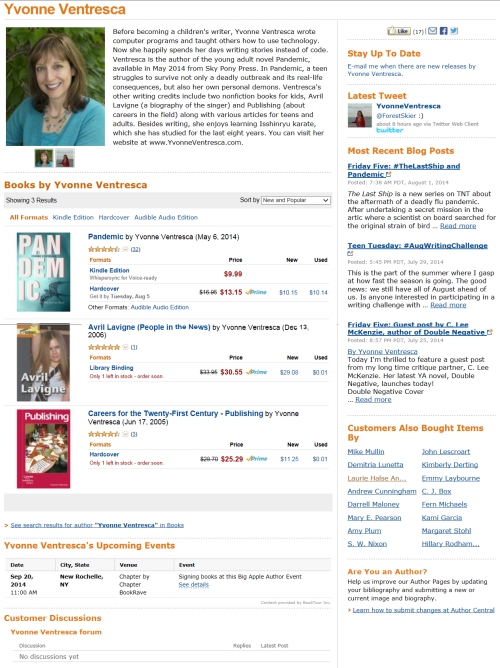
Yvonne has included a lot of the tips on the above list, but I’d like to see her add a few quotes from reviews of Pandemic, a book trailer, and to work on getting a video interview she can put up on the page. Adding these things will maximize the free space Amazon has given her and help increase the sales of her new book.
Good job, Yvonne!
Talk tomorrow,
Kathy
Filed under:
Advice,
authors and illustrators,
Book,
list,
Marketing a book,
Publishing Industry,
Tips Tagged:
Amazon Sales Page,
Maximize Book Sales,
Pandemic,
Yvonne Ventresca 


By: Kathy Temean,
on 8/4/2014
Blog:
Writing and Illustrating
(
Login to Add to MyJacketFlap)
JacketFlap tags:
Tips,
Internet,
Advice,
Process,
article,
authors and illustrators,
Publishing Industry,
Marketing a book,
How to Sell More Books,
Amazon Look Inside,
Amazon Strategies,
How to Sell More Books Workshop,
Add a tag


Let’s take a look at another feature that Amazon offers anyone who sells their books on their site.
Don’t miss out on using this feature. This is another reason why it is important to make sure your first chapter sings.
Personally for me to buy, I look over five things:
Price: I buy lots of ebooks that are offered at $1.99 or less, without having read anything about them.
Cover: I don’t buy books where I don’t like the cover, unless someone else said they were good. I guess I believe in first impressions.
Reviews: I read what book is about and a couple reviews. A few bad reviews don’t stop me from buying, since I’ve read many top-seller books that I thought were great that received a few terrible reviews.
Publisher: I check out who published the book. If it is from a well-known publisher, that could seal the deal right there.
Look inside: If I have not clicked the button to buy, I will “Look inside”. That’s when I put on my editor/agent hat and only give five minutes to the author to grab me before I make my decision. Sometimes the problem is that the book really grabs you and then you have to read the whole thing, even when the desk is piled with work and the kitchen needs to be clean. Many of those books have been self-published, so don’t stick your nose up at them or else you might missed something really good.
Here are some tips on using the “Look inside” feature.
1. Keep front matter to a minimum. You want to make sure the reader can get to the meat of the story quickly. This is also important to do this with the full ebook.
2. Amazon Reviews. Work hard to get as many as you can when you launch the book. This will help raise your ranking and buyers who have read the first pages will look at this, especially if you are self-published.
3. At the end of your book you should ask the reader to write a review. Stats show that this helps you increase your sales numbers.
4. Hot New Releases List on Amazon should be in the forefront of your mind when planning a launch. Talk to your publisher to see if they have planned your novels launch based on other similar books coming out. If there are too many it will hurt your chances of making the list. The list is only good for the first 30 days of a books release.
5. Making sure your blog followers know about your book and doing book tours can help get the word out. It’s nice to get the buzz going, but you need to make sure you keep the big guns for the launch date.
Talk tomorrow,
Kathy
Filed under:
Advice,
article,
authors and illustrators,
Internet,
Marketing a book,
Process,
Publishing Industry,
Tips Tagged:
Amazon Look Inside,
Amazon Strategies,
How to Sell More Books,
How to Sell More Books Workshop 

.jpeg?picon=3498)
By: Cait,
on 8/4/2014
Blog:
Cait's Write...
(
Login to Add to MyJacketFlap)
JacketFlap tags:
tips,
running,
motivation,
injuries,
training,
stretching,
core,
recovery treatments,
cross training,
Add a tag
Nothing unites complete strangers more than discovering they are both, in fact, injured runners. Because let’s be honest, no one REALLY understands the agony us runners go through when we’re deprived of our ‘fix’. Miles give us endorphins, take those out of the equation and you do the math. It sucks.
Run long enough and you’ll get injured. It’s a fact. Darn these humanoid bodies not quite engineered to put up with everything we want them to do in training and racing. This isn’t to say there aren’t plenty of ways we can limit our injuries, and yes, us runners can be quite stupid sometimes in getting ourselves injured, but at a certain point you will get injured despite doing everything you can do right.
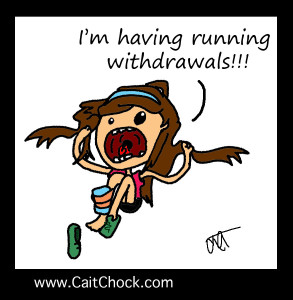
But don’t think of that last line as a free pass to just go willy nilly, throw all caution to the wind then, when you do wind up hurt, pretend you have no clue why. Let’s start with the stupid:
• Denial: Oh we’re the queens and kings of denial, us runners. “It’s not really that bad, it doesn’t hurt that much” thought as we hobble around the house in search of more ice.
• Grimace Face: We know running hurts, but when every stride sends a shooting pain (which you’re of course denying exists) your face gets twisted into a grimace that would make Frankenstein look beautiful.
• Random Prayers: You go to bed praying you’ll wake up and magically everything will just go away. No other logic there but a runner clinging to any shred of hope.
• Eff It, I Can Finish: Said during any run or workout, you’ve denied the shooting pains for as long as possible, somehow still believing that if you just muster on through this run, get done, things will still be peachy keen.
Clearly we all have to learn from our stupid mistakes. We’ve all been there, hopefully the older we get the wiser we get. Because let’s be honest, denial doesn’t change the situation.
Over the stupid, here are the proactive:
• Self-massage: Runners if you’re not in a love/hate relationship with your foam roller, I urge you to get cozy with it. Give him or her a name even.
• Stretch: Static and dynamic stretching post run.
• Core and Strength: Strengthening your core and WHOLE body to limit the compensation issues resulting from weak muscle groups.
• Ice, Smart, Recovery, Etc: You know the drill there.
• Form Work: Ties right into strength, run more efficiently and you’ll be doing less wear and tear on your body.
I’d like to take a minute to emphasize that if you’re not doing some kind of core or strengthening routine you’re not addressing issues that WILL eventually get you injured. Not a single runner in the world pops out perfectly balanced and with perfect biomechanics. Most runners have tight hips and weak glutes, just two major issues that cause many a runner heartache come injury time. What’s more is there tends to be a little too much emphasis on stretching alone. YES you need to stretch, but save some of that time for core work because you can’t stretch away a weak muscle group if you get my gist. I’m not talking about hitting the weight room like a Jersey Shore’r (a little dated reference but I was watching a comedy earlier that did a bit on that so it’s on my mind), and in fact many of the most effective exercises for runners can be done with bodyweight or with a swiss ball. I did some posts HERE with some of those.
Crash Course: Mentally Surviving an Injury
Back on topic. So you do your preventative but like I said injuries will occur. When you’re laid up you’ll most likely experience a few emotions.
• Rage: Like wanting to literally rip off your leg just so you can smash it against a wall, infuriated that ‘it’ let you down.
• Remorse: I abstain from the word depression, but it’s like a hair away.
• Anxiety: Is this going to EVER end? Will I EVER be able to run without pain, ever? Getting up in the middle of the night to go to the bathroom and you sorta ‘test’ jog down the hall, “Crap! Still hurts!”
• Envy: Oh that lovely runner envy. Daydreaming about hopping out of your car and slapping in the face the person you see running down the street. It’s not something to be proud of, but every injured runner thinks it. 
• Rage: Yea, you circle on back to rage.
I blame it on the lack of ‘proper’ endorphins for our crazy train ride of emotions and THESE are the things that our family and friends tend to have a hard time grappling with. To every runner who’s gotten, “But it’s just running” and you have to literally hold your arm down from punching that person in the face…yea, that’s a normal runner reaction.
The thing is, while I like to joke and jest and be comedic about Runner Rage (it’s totally legit and an excuse that I think should hold up in court, “Sorry, I’m not fully in control of my actions, I’m a runner who’s not able to run at the moment”) I’m also the first person to say this:
“Force that positivity down. Choke it down and keep it there. Fake it.”
Yup! That’s the only way to get through an injury. You keep yourself OUT of that depressive and overly-anxious mindset because if you don’t you’ll stay right there…stuck.
How I deal with Runner Rage is making fun of myself and being sarcastic. Rather be laughing than wallowing in sadness. What also helps is to feel proactive during your recovery meaning: cross train, core, massage, find out where your weaknesses are and target them. Come up with a recovery plan and start the execution. The other really important thing is:
Take it ONE day at a time.
Think only through the day. Because thinking of weeks and weeks of the elliptical or bike is, well, depressing, right? So just get through the day.
And there is always this: you’re not alone. There are other injured runners out there. And there are non-injured runners who know EXACTLY how you feel and what you’re going through and they sympathize and are sending you heal up fast vibes!


By: Kathy Temean,
on 8/3/2014
Blog:
Writing and Illustrating
(
Login to Add to MyJacketFlap)
JacketFlap tags:
Tips,
success,
Advice,
article,
How to,
Amazon Rankings,
need to know,
Marketing a book,
demystify,
How to Sell More Books,
Amazon Book Sales Strategies,
NJSCBWI 2014 Workshop,
Add a tag
This week we will look at a few strategies you can use to increase the sales of your books.

If you buy any books on Amazon, you may have noticed they list the Best Selling Books. You should give these categories some thought. It may help you get on one of their lists and getting on one of the lists will greatly improve your chances to get noticed and bought.
1. Try to choose a niche category on Amazon. There are less books, so you will have a better chance to be listed at the top.
2. By clicking the book ranked #100 in any given category, you can consult the Rank to Sales Estimator to see how many sales you need to qualify for that categories Best Seller List.
3. Self Published authors get to choose two categories.
Traditional publishers get to choose up to five categories. Make sure your publisher knows how the system works and how they can use it to their advantage. Choosing “Fiction” might not be the best category due to so many books. (over a million)
4. Example: Kindle Store> Kindle ebooks > Fiction> Mystery, Thriller & Suspense> Thrillers> Political. Your books will still show in all the categories above the one you chose.
A few scenarios:
Fault in Our Stars [Kindle Edition]
Amazon Best Sellers Rank: #6 Paid in Kindle Store (See Top 100 Paid in Kindle Store) This a list of all books (no categories)
#1 in Kindle Store > Kindle eBooks > Teen & Young Adult > Romance > Contemporary
#1 in Books > Teens > Love & Romance
Isla and the Happily Ever After [Kindle Edition]
Amazon Best Sellers Rank: #11,151 Paid in Kindle Store
#100 in Kindle Store > Kindle eBooks > Teen & Young Adult > Romance > Contemporary
The First Third [Kindle Edition]
Amazon Best Sellers Rank: #172,765 Paid in Kindle Store (See how this book was able to make the Top 100 List by picking Social Issues? That’s because there is less competition. This helps give the book a chance to be seen.)
#100 in Kindle Store > Kindle eBooks > Teen & Young Adult > Social Issues
The Year We Disappeared: A Father – Daughter Memoir [Kindle Edition]
Amazon Best Sellers Rank: #9,006 Paid in Kindle Store (See Top 100 Paid in Kindle Store)
#1 in Kindle Store > Kindle eBooks > Teen & Young Adult > Social Issues
#5 in Kindle Store > Kindle eBooks > Teen & Young Adult > Biography
#33 in Kindle Store > Kindle eBooks > Nonfiction > Children’s Nonfiction
Neverwhere [Kindle Edition]
Amazon Best Sellers Rank: #2,867 Paid in Kindle Store (See Top 100 Paid in Kindle Store)
#10 in Kindle Store > Kindle eBooks > Science Fiction & Fantasy > Fantasy > Classics
#11 in Kindle Store > Kindle eBooks > Literature & Fiction > Contemporary Fiction > Fantasy
#79 in Books > Literature & Fiction > Genre Fiction > Horror
5. Make sure you check to make sure the category you pick is on both the book side and the kindle side if you have a print book. Some of the categories do not match up.
6. If you are self-published you will need to do this for yourself, but don’t assume your publisher is choosing the best categories. Do your homework and discuss what you have found with them. But make sure you do this before they list it on Amazon.
Talk tomorrow,
Kathy
Filed under:
Advice,
article,
demystify,
How to,
Marketing a book,
need to know,
success,
Tips Tagged:
Amazon Book Sales Strategies,
Amazon Rankings,
How to Sell More Books,
NJSCBWI 2014 Workshop 


By: Kate Leonard,
on 7/24/2014
Blog:
Illustration Friday Blog
(
Login to Add to MyJacketFlap)
JacketFlap tags:
tips,
dreams,
business,
advice,
artists,
goals,
creative business,
aspirations,
Creative advice,
Add a tag

We all have dreams and aspirations they grow within us from any age, from the time we’re two years old and scribbling on any blank piece of paper in sight to the years in university when your dreaming up a life of bigger things you want to do and places you may want to go. Although as time goes by sometimes unless your extremely determined you can feel swayed or lose sight of the things you dreamed of and that’s why you need to grab a pen and sketch them out.
Sketching out your dreams keeps them in sight, gives you a reference to go back to when your feeling a tad lost in your aspirations or feel your not sure where your going. So here are 5 steps to sketching out your own creative dream for 2014.
1. Grab a huge piece of paper or wallpaper roll across the floor , a couple of pens and your inspiration and start doodling and jotting out your aspirations and future plans.
2 . Break them down with someone who motivates you the little steps you need to do to work towards those dreams ( They don’t seem so far away when the two of you narrow them down into tiny steps).
3. Start paving roots and pathways to begin implimenting your plans .
4. Meet new people and make connections with those who might help you on your way to where you want to be :).
5. Block out those niggling negative thoughts and “I can’t do this”, stay positive if something doesn’t work out brush yourself down and keep going as being self motivated is key and the effort you put in is sure to pay off.
Image by Designer Alyssa Nassner you can find more about her and her designs “here”.
Long runs and long workouts tend to scare people. It can feel intimidating looking down the barrel of a double digit run or mulit-mile repeats. We’re distance runners, we love this stuff, but large quantities of miles (especially faster miles) still intimidate us.
Running and that mental component, can’t escape the mind games. Our bodies are apt to surprise us and prove our limit-setting minds wrong…BUT it’s a matter of pushing past the mind crap (doubts/fears/discomfort) before we can be ‘pleasantly’ surprised.

The best thing about running into new territory, be it your longest run, the most number of long intervals, or the most volume of hard running, they’re all scariest before you do them. Once you’ve conquered the best you’ve proven you’re capable of it and you get a new frame of reference.
Example: You’re afraid of running 10 miles because you’ve never run that far. You then run 10 miles and flash forward a few weeks and 10 miles doesn’t scare you at all. But 14 miles does…sooo, you run 14 miles and the cycle continues.
See how DOING something takes the fear out of it. Let’s up the ante.
You can run 10 miles but now you’re supposed to run them hard. EEK!!! New challenge. Time to fight through it:
4 Steps to Get Through the Grind
1) Relax:
the first part is you gotta stop building the run or workout up into epic proportions. Say with me, “it’s just a workout (or race), all I can is my best, so that’s the goal.” Deflate some of that pressure and take the power away from the workout…give yourself the power by realizing that you’re going to give it your all and THAT is all that can be expected. Times are there for guidance and
motivation to push…but you can’t let them put so much pressure on you that you implode.
 2) Start:
2) Start: easy peasy, right? Funny how fear sort of get muted the
second the gun sounds and you just START freaking running. It has a way of shutting your brain down for a bit or at least taking it down a few notches.
3) Segments: your runner-brain gets overloaded thinking about the WHOLE run (26.2 miles…holy crap!!!) so you break everything down into smaller segments. Think of it like a meal with a zillion courses if you have to. Get through the plate, the miles, the quarter mile, the repeat.
4) Fight and Lie: running isn’t easy and training is painful. You break it down into itty bitty ‘plates’ but even each bite is still hard. (can I push this metaphor any further?) You need to just cycle through the above three steps on repeat…relax, roll, be confident, be smooth…start, click the watch on that next interval and go, make it until you hear the magic Garmin beep of another mile and keep going…segment, make it 100 meters more, run until you pass that guy, stick like GLUE behind the person in front of you and don’t think how far the finish line is in front of you.
Doing all of the above is really a series of lies. The good lies that you use to ‘trick’ your limit-setting brain into proving itself wrong. Your body CAN keep going, you just have to fight like h*ll long enough to show yourself you can do it.
The cool thing is once you get through the grind you’ve just re-calibrated what’s ‘suuuper scary’. Whatever you just did won’t scare you so much next time…
…but don’t rest too easily, Runners, because that just means later the ante will be upped. That’s okay, because you know the drill. 
——
“The Big Three: Talent vs. Work Ethic vs. Mental Toughness- Which matters the most?”
“Effective Mental Strategy: Race better by out-thinking your brain”
——
1) What’s the longest you’ve run?
2) What’s your favorite long repeats workout?
3) How do you get through the grind?

The last few days my Adobe was acting up, legit like a two year old heck bent on crippling me. I couldn’t finish work that NEEDED to be done, I cursed the computer and slammed some fists. It had turned ME into a toddler. Hot mess.
Stress. Frustration. Anxiety. We can’t avoid it in life and we can’t avoid it in running either. There are ALWAYS going to be things totally out of our control. My tantrum wasn’t going to solve the computer issues, and neither is the wildest of fits going to cure a stress fracture. Sometimes sh*t just sucks but you NEED to deal.
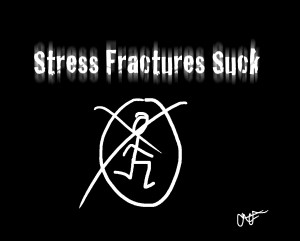
In the moment that can feel impossible but our fast-paced lives have gotten to a point where the stress, anxiety, and frustrations churning through us are destroying us. Making us sick. Clearly even if you’re not on the verge of a stress induced heart-attack or breakdown, I dare say everyone and anyone has some sh*t going on that they would do well to unburden themselves with.
What do I mean by unburdening? You most likely can’t take away or change every situation, you can’t make money float down upon you or force so-and-so to get back to you with a quote that you NEED because your article deadline is hours away.
Unburdening can be more like shifting how YOU are dealing with the situation. Adjust and learn to let go. I’m sum it up:
Do EVERY single thing you can to control the situation and make it work how you’d like it to…from there, heed to the ‘que sera, sera’.
Injury?
You get hurt, injuries come with the territory in running. Do what you can to reduce your risk but you can’t avoid them. Here are your three steps:
1) Throw your dang tantrum. You deserve it. But put a time limit on your baby breakdown. Ten minutes, a day max.
2) Get proactive. Shift to problem-solver mode (logic and reason side of the brain, move out of emotional/reactive side). Come up with a cross training and rehab routine.
3) Do it. Move through that routine and ONLY take it a day at a time. Don’t dwell on XXX weeks or months. Look at your rehab like taking your medicine…spoon full of sugar that crap down. 
Bad Race or Workout
Also comes with the territory in running. Ironically the steps are eerily the same as above:
1) Mild upset is allowed. You deserve to be disappointed and that’s the same feeling that will motivate you to work harder next time. But don’t be a pouter, don’t be one of those jerks who ruins everyone else’s workout/race/day/etc. Cry on the inside like a champ. Haha.
2) Get proactive. Learn anything you can from the experience, is there a reason it was bad? Reassess your training if need be.
3) Move on. Keep on trucking. Some days your legs just don’t show up for whatever reason. Learn what you can the move forward.
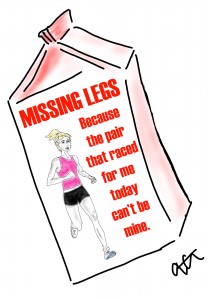
Never let a bad workout or race turn you into a pessimist. That kind of perspective is what kills peoples’ passion and could ruin your love of running. No one wants that.
All that stress and anxiety [psst...don't get too nervous before races either, here's my post on that.] only makes things more of an uphill battle for you. So don’t make things worse on yourself. Unburden that sh*t.
Ironically, the more balanced and less stress you put on yourself in running the better you end up performing. There’s a little thing called over-thinking, My Friends.
Back to life because 99.9% of us aren’t running for our jobs. Which means our jobs and life events are brining us the most stress. [that extra stress will effect our running too...so if you're also wanting to run better you'll do well to unburden some life stress...logic holds there. Haha] But far too many of us let things that shouldn’t stress us out THAT much, well, stress us out THAT much.
I challenge you to let go of some little things. Lots of those things include wondering what someone else thinks about you OR complaining about someone else. A tip there, years ago I adopted the thing of not saying anything about someone else that I wouldn’t just say right to them. I’m a straight-shooter so rather than complain, isn’t it better to just go to the source and [strategically] say whatever you need to? Problem solved there.
Now for the curveballs and bigger things life will deal you often, we’ll circle back to what I suggested we do in running. Hey, like I say EVERYTHING circles back to running, right?! 
1) Baby tantrums. You can be entitled to a fist pound on the laptop but put a time limit on yourself.
2) Proactive mode. Do EVERYTHING you can to set yourself for the best outcome.
3) Move the heck on. You can’t control lots of things in life, namely other people. So…”let it go.” 

Stress makes you unhappy, it will also make your running harder. All the more reason to unburden some of that crap!
1) What is one little thing you’re going to unburden yourself with TODAY?
2) How do you handle BIG life stress?
3) Do you consider yourself a highly stressed and anxious person?


By: Kate Leonard,
on 7/16/2014
Blog:
Illustration Friday Blog
(
Login to Add to MyJacketFlap)
JacketFlap tags:
advice,
freelance,
aspirations,
Creative advice,
aims and goals,
motivaton,
self expectations,
design,
tips,
creativity,
Add a tag

Following the creative path to live a creative life isn’t always an easy instant road to success. You’re going to put in the effort and hard work so you’ll no doubt get there but like any journey there will be challenges to face and obstacles to overcome to become who you want to be. Whether you’re a current art student at college, just graduated from university or are bettering your creative practice in your own time with the aspiration of running your own business there’s one teeny tiny obstacle we all have niggling away inside called “expectations”.
Expectations can be anything from aims you set to accomplishments and standards you may put on yourself or those that people around you may have of you themselves but today I’m going to cover self expectations. Having expectations in general isn’t a bad thing as they give you points to work on and creative insight into ways you’d like to grow.
However sometimes when we set such high aims to reach and aspiring results to follow, when we fall short it can really knock us down and sometimes make you second guess what you’re doing and why you’re doing it. You may find yourself questioning whether you did something right, whether your skills are at their best , if you met the brief you were set and whether you can be as good as the next guy the list goes on and you’re not alone in thinking so.
However amongst all this expectation you also need to be your biggest motivator and you need to brush yourself off and tell yourself “Believe you can and you will achieve all you set out to”. I believe you can achieve anything if you put the effort and the hard work into all that you do, although one thing you must truly believe in is yourself. Remember these few things when you feel your inner expectations are clouding your creative motivation;
1. Your work is surely to be at its best when you are as well.
2. Everyone’s story and journey is different don’t compare your beginning to someone else’s middle.
3. A success is to be perceived through your own eyes, however if you don’t try you’ll never know how far you could have gone.
Featured image created by designer Stephanie Ryan and you can find out more about her and her beautiful designs “here” .
I had a fun dialogue with a friend and editor the other day:
“‘How to Train for a Marathon in 5 Minutes a Week’ and ‘Eat 20 Apples a Day to PR’ (clear exaggeration but you get the point). I know a lot of people like those types of articles but over the years I’ve have my fill.”
“Thank goodness you hate the ‘fluff crap’ kinda articles too. I die a little inside every time I’m asked to do one, writing that stuff makes my brain numb.”
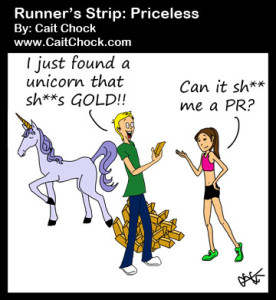
There were more little barbs in there and witticisms but you get the picture. The ‘fluff’ crap; it’s all over the web and even in the magazines and websites ‘we’ us ‘real runners’ read and subscribe to. We can’t escape it and let’s be honest the masses are looking for a kind of ‘quick fix’. So, the headlines screaming BIG rewards LITTLE work draws people in. It sells. Websites and magazines are businesses after all, so even though I’m sure it kills a few editors and writers every.single.time they must do a ‘fluff crap’ article, they do it. Gotta put food on that table.
The thing is though, which ‘we’ ‘real runners’ know is:
* there’s no magic bullet
* no super secret way to getting better and stay fit
* eating an apple at 3:19pm to drop 30 seconds off your 5k PR aint gonna do it
Most people don’t want to hear that it takes:
* a h*ll of a lot of hard work
* motivation
* motivation even when you aren’t motivated
* pushing yourself
* hurting in workouts and races
The sufferfest that is training and racing…that probably wouldn’t be a magazine the general public would just LOVE reading about. Better to think that a protein smoothie with chia seeds is all that’s required and will do the trick. Training and all that stuff, well…that’s second tier, right? 

The ‘training fluff crap’ I think actually parallels what writer, coach, sports nutritionist, and athlete Matt Fitzgerald, writes about in his latest book DIET CULTS. I literally devoured that read in two days so do check it out, I think most fitness minded folks will relate to a lot of what he’s saying and laugh because as athletes we’re able to ‘sniff out’ lots of the ‘diet fluff crap’ mainstream media and individuals try to get us to buy into. I will revisit this book later because I’ve got both an article on RunBlogRun coming out and after that is published do a review on this blog. So hold tight, but in the mean time check out DIET CULTS.
Getting back to the fitness and running ‘fluff’, I find that it really is only doing a disservice to the individuals who really are motivated or the ones just starting out in the sport. Coming to the realization that it’s hard work over really anything else is a learning curve all runners go through. Experience teaches us that.
Every single runner has their own journey, the progression of getting crazier and crazier more experienced and for lack of a better term ‘hardcore into’ our sport. That journey makes each runner who they are and it’s important to learn lots of those lessons yourself. At the same time, it’s a shame that falling into the misconception that certain foods or cramming 4 months of training into 2 weeks doing a run only every other Tuesday WILL make you a better runner. Because by hiding the truth you’re only stunting the progress of the runner who really does want to be their best.
Certainly the ‘fluff’ sells and the driven, self-motivated folks who are ‘real’ runners [I only define 'real' runners not based on speed at all, but in spirit and how motivated they are...if you're a runner you know it in your bones.] are the minority. But the numbers of runners are growing and it proves there are eager, motivated people looking to embark on their running journey.
Welcome to crazy town.
So here’s some straight shooting for you:
* It’s going to hurt.
* There’s no ‘secret’ to getting faster and staying fit.
* Motivation is your weapon, consistency reigns supreme.
* Patience sucks but it’s required.
* Learn that
unnecessary suffering isn’t going to make you better. Oh running, filled with all those fine lines we must tread.
But here’s the BEST part:
* There’s a sick sort of high and remarkable afterglow to that hurt when you’ve pushed through it.
* Nothing is more rewarding than watching yourself get faster and more fit.
* Realizing your body can DO things you never dreamed possible is far more satisfying than any pack of abs or what your vehicle of performance looks like.
* Running will effect, and improve you in all areas of life.
* Runners are tough as s*t.
It’s important to realize that clearly certain foods and a healthy diet will help your training, lifestyle adjustments (hello more sleep!) will too. But even a healthy diet with 10 hours a sleep at night is useless sans training. Take your ‘fluff’ and shove it. #run
More Reads:
5 Ways Runners Can Use Trail Running to Get Faster
What’s Fueling YOUR Run?
Runger: How runners can tame the beast and eat to perform
WEAR your motivation with Ezzere


Though running your own creative business is an exciting venture finding a balance between life and what you love to do is pretty hard to find. Sometimes it too easy to become engrossed in putting loads of time into your creative venture to start building things up from your portfolio to your website , however in your pursuit for quicker results this can often lead to becoming frustrated with what you draw and feeling things just aren’t panning out right (believe me I’ve been there). This is why balancing out your creative life is important, working too hard or intensely on your creative practice can wear down your idea’s and prevent you from creating things you are happy to shout about and share with others. So here are 3 tips to a balancing out your own creative life;
1. Find time to do the other things you love
Finding time to do things you love that’s outside of the business is important, this can be anything from sport to other creative activities and though I know how much you may love to design , stitch , doodle and paint taking the time for yourself will just give you not only time to chill out but also gain new ideas and inspiration from other places.
2. Find time to do things to wind down the creative trail of thought
Repeat after me “I’m going to relax , slow down and put my feet up for a minute” , if like me you’re the biggest culprit for not relaxing then hopefully this tip will help quite a few of you . If your mind and body are active all the times you can easily wear yourself out so things like yoga is a great activity to do to just really wind down your mind and body not to mention its good for your health , although if yoga’s not your thing there are other things you could try to chillax and wind down.
3. Socialising with people you know
Being creatives we love feeling cosy in our own personalised creative spaces, although there is one catch working from your home studio can be a little isolating unless of course you rent a studio space situated with other creatives . So it’s important to get a break away from your work even for a little while to share thoughts with other like minded people or close friends giving you food for thought or breathing space to recharge your batteries before getting back to work.
At the end of the day it’s important to remember that your creative business will only work at its best when you yourself are at your best aswell. The key thing is to just have fun with every project you do but also have fun outside of the business at the same time because finding your own personalised creative balance is sure to help it grow.
Image by designer Vicky riley you can find more of her work here .
Trail running makes you strong. It can also make you faster. “But wait,” you think, “I look down at my watch Garmin afterwards and the times are slower!” Ahhh…it all comes back to effort, My Dears, effort.
Hills take a LOAD more effort running up than running on the flats. #lessonfromcommonsense Haha. Force those legs of yours to put in the extra effort needed to get up those inclines thought and you’ll build power. Now a lesson in running mathematics:
Power = Strength = Speed

Blast up those hills and the second you take it to the track or flats, you’ll be thinking how much ‘easier’ it feels. This summer, take it to the trails (the right way) and you’ll come out stronger, faster, and ready to kick butt. It’s not just about ‘base building’ it’s about ‘power building’.
5 Ways to Do Your Power Building Trail Running RIGHT
1) Get Efficient:
You’re not doing hills right if you’re
hunched over like Quasimodo. Hills make it even more important you hold proper form. Check out my post on form
HERE and when taking it to the hills remember:
* Stand Up TALL: Keep that torso straight!
* Don’t Lean: Don’t lean too far into the hill, keep your center of gravity above your hips; your hips will naturally be SLIGHTLY leaning into the hill, but you should think in your mind about standing up straight because quite honestly you’ll probably ‘feel’ like you’re leaning WAY back behind you but in reality are where you need to be. Focus on staying upright.
* Shorten Stride: Keep the same effort running up the hill but shorten your stride. Focus on the faster turn-over and power up that hill!
2) Eyes Ahead: Keep your eyes focused on the top of the hill, you want to power all the way UP and THROUGH the crest. Too many runners make the mistake of powering up and stopping juuuuust short of the crest which means they lose all that momentum they worked SO hard for getting up. Run THROUGH the hill so you can use that momentum to power down it.
3) Blasts vs. Endurance: Just like track and flat speedwork, hill running workouts should be tailored to match the goal for the day’s workout. Short 10-30 second hill blasts can be thought of like plyometric work. It will REALLY build that base speed, it’s all fast twitch; so remember to take FULL recovery for short blasts, as is the law of the sprinters and taxing the anaerobic energy system. Longer hill repeats and doing tempo workouts on a hilly course will further build that endurance and strength so when you take it to the flats the same EFFORT will yield much faster times. It’s always cool to step from the hills to the track, look at the watch and surprise yourself, no? 
4) Rolling and Exploring: Even doing your easy days on the trails will build power. Over time the ups and downs make you stronger; it’s important to keep your easy day EFFORT easy though so you’re still actually recovering. So again, ignore what the watch says and run for effort.
5) Downhill Running: It’s important to remember that everything that goes up, goes down. #duh Running downhill puts a lot of stress on the body and as any Boston Marathon runner can tell you downhills can REALLY do a number on those quads. Downhill running isn’t ‘easy peasy’ on the body. So if you’re training for a race with lots of downhills it’s smart to practice running downhill. If you’re prone to injury beware, because the extra pounding can cause knees and ankles to get cranky. Final tip on running downhill: don’t FIGHT it. Relax, let gravity help you, and don’t try to fight it…roll with it, Runner Babes.

So if you’re not sold on hills and exploring trails, and that they will make you faster, yet…just go to Instagram and check out some of those nature pix those avid trail runners are posting! The miles will fly by. Go out…explore, adventure, LOVE the run!
——–
CHECK IT OUT!! Ezzere made Competitor’s list for TOP fitness tees!! Wahooo…the Peacock Runner Tee, sitting at number 3 on the slideshow. 
——–
1) Best, most amazing trail run you’ve even been on?
Nisene Marks Park in Aptos, CA. Go there.
2) Favorite hill workout?

Prep your hot pressed watercolor paper while it is still attached to the watercolor block.
Although watercolor blocks lean more on the expensive end, they are far more easier to work with. You don't have to stretch your paper with tape or a staple gun.
Simply spray your paper so it is saturated with a spray bottle. Next, take a flat brush and even out the water on the paper's surface. Lastly pick up any water that drips on the sides of your block or table surface with a paper towel.
Let it dry completely before you transfer your image or begin painting.
By doing this it will loosen the sizing in the paper and allow the fibers to relax, which in turn will let the watercolor absorb easier into the paper. If you don't prep the paper with water on hot press, you tend to get a more wax resist reaction.
Happy painting!
:)
I live in California so even though June 21st is ‘officially’ the first day of summer, I’ve been running in a hot box for weeks already. Never fail, during some of my summer runs I always get that Bush song, “Speed kills…” stuck in my head but I swap out the word to “heat kills”. #truth
Running when the brutal sun is scorching you isn’t my favorite thing. But until we find that perfect seasonless runner utopia we must deal. For those runners in humid states, good lordy I’ve spent some time running in those conditions and had to come back and wrench out my running shorts and sports bra, easily a couple cups of sweat there! haha.
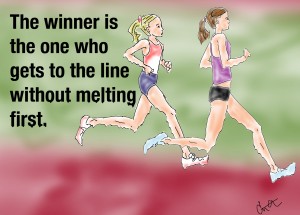
So here’s my running summer warning and tip round-up:
* Beat the Heat:
If you can, it seems like a no-brainer to try and get up and go run before the sun and temps are up, or wait until the later evening.
* Acclimate: Here is where you SHOULD actually force your runner butt to run in the heat. If you’re going to be racing under sweltering conditions you NEED to start getting your body used to running in the same conditions. The first runs, and especially hard workouts, are going to not feel all too pleasant. But eventually your body will start to adjust…you do NOT want the first time you go out and run in hot/humid/both conditions to be on race day when you’ve been doing all of your training at 5am to beat the heat. It’ll be like a body slam sucker-punch on race day.
* Hydrate…they hydrate some more: I’ve done some posts
HERE and
HERE all about hydration. But this needs to be BEATEN into your HEAD here. Hydrate religiously throughout the entire day!! You should be peeing darn near clear, by the time you feel thirsty you’re mildly dehydrated. Also make sure to get those electrolytes replenished as well.
* GI Issues: It’s no coincidence that your tummy may become more upset when the temps rise. I did a post
HERE explaining just how much dehydration can be the root cause of lots of running GI disasters. So another reason to stay hydrated…ooor, just go poop your pants…your choice.

Now let’s talk about doing hard workouts and races in the summer scorchers:
* Easy Does It: We already know that going out too fast can be the kiss of death. Doing that in the heat is like putting yourself through Dante’s extra levels of h*ll. You might feel okay at the start but it’ll come slap you hard in the body/face/legs later. This is where you should be running for EFFORT and not times…the heat and humidity are two big factors that slow down times. So adjust your paces accordingly and the power of negative splitting is much friendlier than the brutal kick your butt punishment of going out too fast.
* H2O Cool: If you’re at the track, bring extra water to douse your head and body between reps. Obviously keep some to take sips on, but getting that body temp down the hose-to-head method works well too.
* Seek Shade: Ahhh-duh. If you can find shadier trails to do tempo or fartlek runs on then it’s a no-brainer (vs. an uncovered track). But I also wanted to add this one in here meaning that if you’re doing a track meet and are doubling/tripling/etc. get you butt in the shade as much as possible. No need to have extra energy zapped out of you lingering in the sun unnecessarily.
Whew…and after that, just dream of ice cream and guzzling the entire river once you’ve finished the run. 
1) What’s one of your summer running tips?
2) How bad are you tan lines?
I could blind you from 10 miles away. 


By: Kathy Temean,
on 6/13/2014
Blog:
Writing and Illustrating
(
Login to Add to MyJacketFlap)
JacketFlap tags:
Tips,
picture books,
inspiration,
Technology,
Advice,
Process,
illustrating,
Buenos Aires,
demystify,
Illustrator's Saturday,
Marcelo Elizalde,
Add a tag
 Marcelo Elizalde was born in Buenos Aires, Argentina, in 1953. He is a self-taught, dedicated children’s books illustrator.
Marcelo Elizalde was born in Buenos Aires, Argentina, in 1953. He is a self-taught, dedicated children’s books illustrator.
At school he considered his drawings as average, but his peers and professors saw a difference that he hardly acknowledged. What really differenciated him from other children was his rather excessive love for cartoons and picturebooks. Pictures, especially those intended for children, made him dream of something that he could not fully understand.
In Argentina he contributed to the most important publishers of books and magazines, and after the year 2000 he started to work for abroad. He began by Spain, but soon he added clients in the USA, Korea, Sweden, Canada and other countries.
A few years ago, he started teaching Children’s Books Illustration at the main art school in Buenos Aires, what made him review all he knew about the craft and conceive a conceptual basis for a criticism of the images intended for children. He is nowadays writing a book about the subject, that has his mind in a state of continuous bubbling, which he says, “makes him look a little absent-minded, or deranged, if you will.”
HERE IS MARCELO:
I work with an iMac 21.5″, 8Gb RAM, OS Mavericks; an Intuos 4 graphic tablet, and an Epson V500 scanner.
The application is Photoshop CS6

Step 1
I very rarely draw directly on Photoshop. I feel that the tablet has this limitation and that I cannot move my hand with grace to set the first ideas on paper. There are some illustrators who do not start in paper, to whom I strongly recommend to use the pencil. The sketch comes out faster and dances better.
I sketch on a light semitransparent paper that lets me trace and refine the sketch. When I have it as I wish, i.e. precise where I need and loose where I am more confident, I scan it to 300ppi.
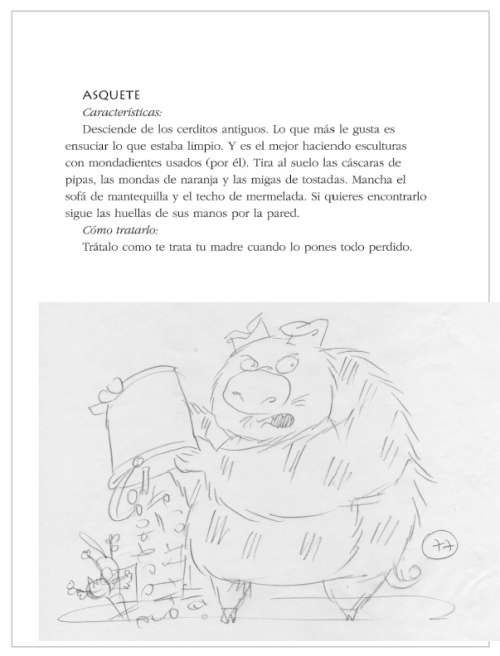
Step 2
I always work upon the very layout, to be sure that the image is always in place in relation to the whole graphic space. When needed, I do it on the spread, so that both pages talk smoothly-or at least not fight to death. For that, I open the PDF of the layout as individual PSD files and save them in this format. I paste the scan of the sketch and put it in place and resize it if needed.
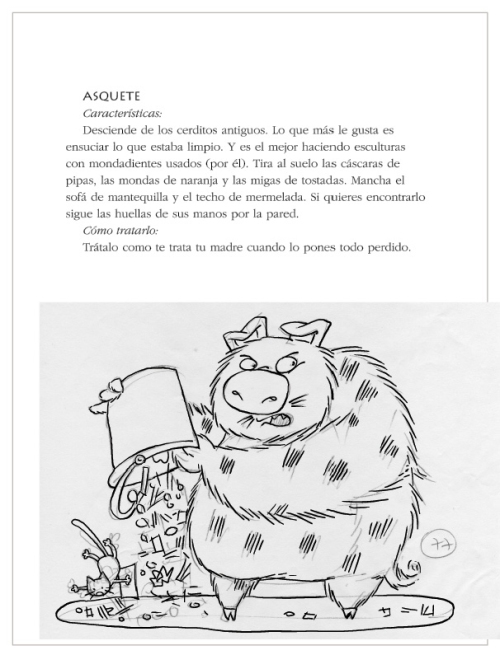
Step 3
I open a new layer, fill it white and reduce its transparency to a value that lets me trace the drawing with a black common round brush.
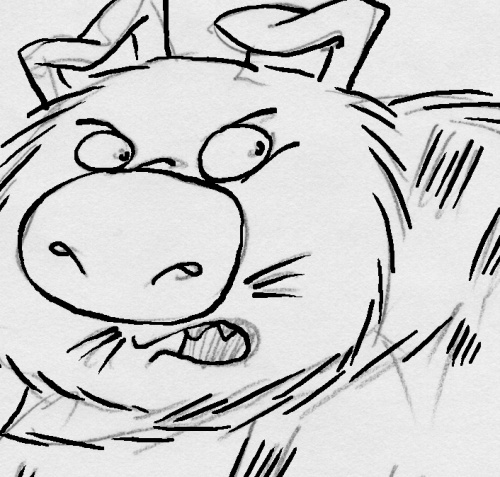
Step 4
I put a special attention in refining these lines so they have movement and profile and they don’t appear blunt or clumsy. I think that every bit of the illustration must have a beauty of its own and not depend on fellow sectors to look good.
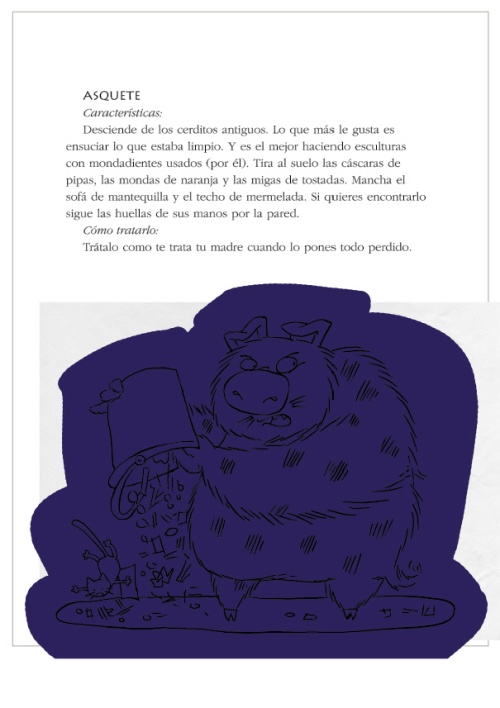
Step 5
When I´m done with the black lines, I open a new layer below this one and set a background. It can be any color, as long as it is dark enough to be visible when I “paint” the subject. I prefer dark blue, or red, or an earth hue.

Step 6
In the times when the capabilities of Photoshop to build brushes was very primitive, I made this one up for very general painting purposes. And albeit I now have a box full of gorgeous brushes, I still use this one from time to time. I named it “Ancient” in the brush presets box.
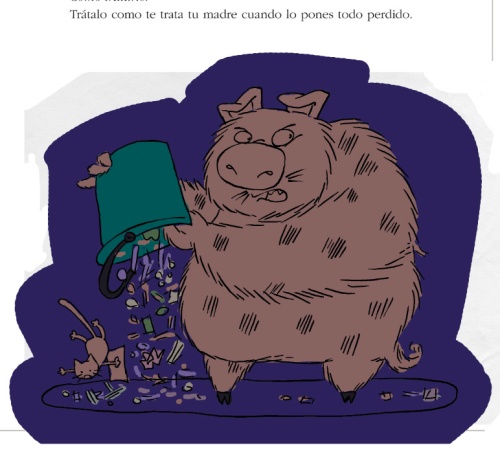
Step 7
Between the blue Background layer and the black line layer, I open a new one and I paint a background that will belong to the subject and that will give it the desired general hue. I chose a brownish color and set the layer to 50%. This I do so as to help the image have a chromatic coherence, as if working with washes of paint.

Step 8
I start the always uncertain process of applying color in steps, using the Ancient and varying the transparency with the pressure of the pen. First darker colors, then the lighter.
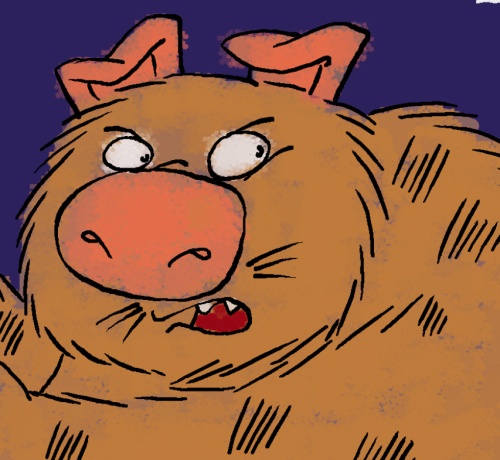
Step 9
I keep on applying layers of “paint”. You can see the blue background a little through this layer. It may not look like very important, but try otherwise and the difference will be huge.
The application allows me to go back some steps and retry and again and so forth. Luckily, you can’t see my doubts here. See that the borders f the paint are slightly loose with respect to the outline.
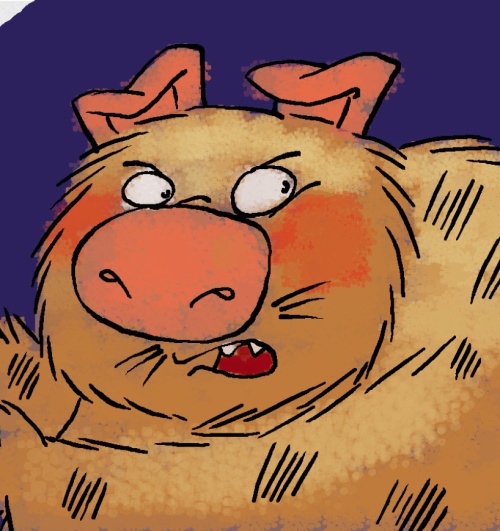
Step 10
I apply the lighter color in the illuminated parts. By default, I make the light come from above to the left.
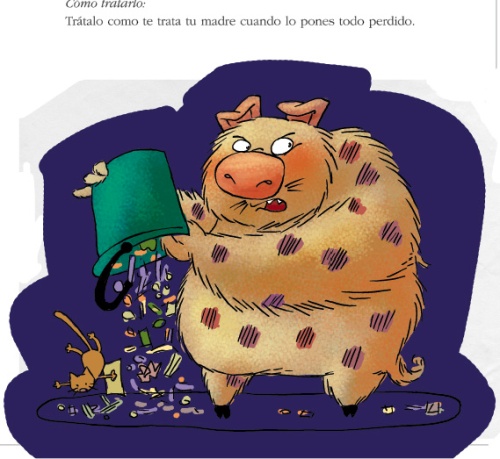
Step 11
I continue with the other subjects and objects of the scene.
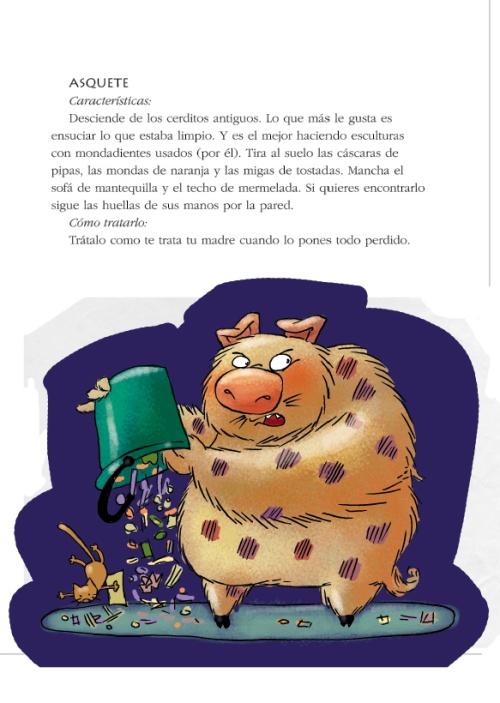
Step 12
Added the color to the ground that the subject is standing on. I apply, always in a separate layer, the highlight, generally in white.
I do it in a separate layers so as to control the intensity by varying the transparency of the said layer.
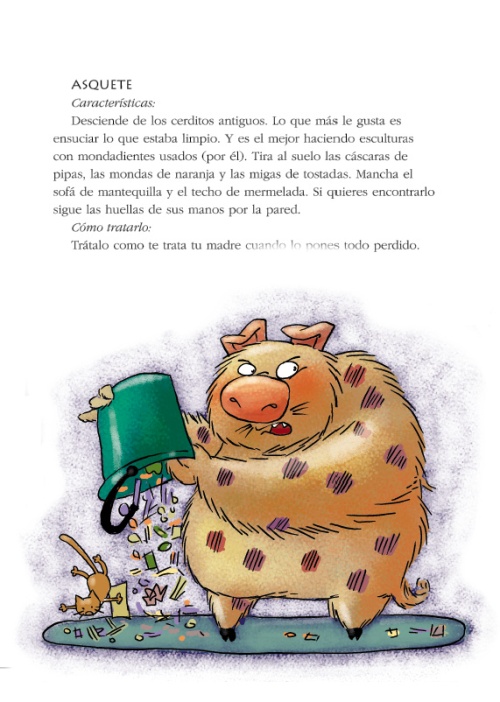
Step 13
I open a layer above the blue background and, using again the Ancient, I proceed to “smudge” it to produce a soft, textured new background, suited especially for illustrations that either don´t need a scenery or are requested as standing alone in the blank of the page.
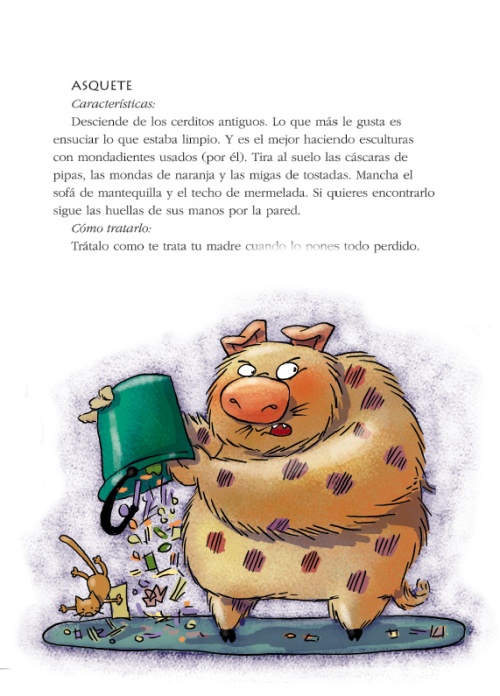
Step 14
Finally, I apply the heavy Shadows layer. For that, I open a new one and set it in Darken mode, 25-30% opacity. Then I (usually) draw flat shadows with blue C100 M100 Y0 B0.
I set it in Darken mode so the details underneath are not painted over but are modified as if under a shadow. I change the transparency according to the color of the subject and the need of stress or character.
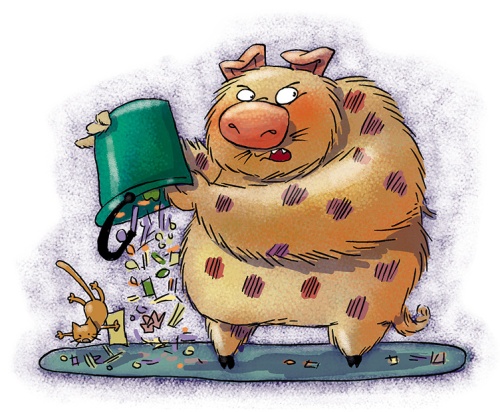
Step 15
This is the final picture as I give it in. CMYK, 300ppi, TIFF format.
I hope you like it.
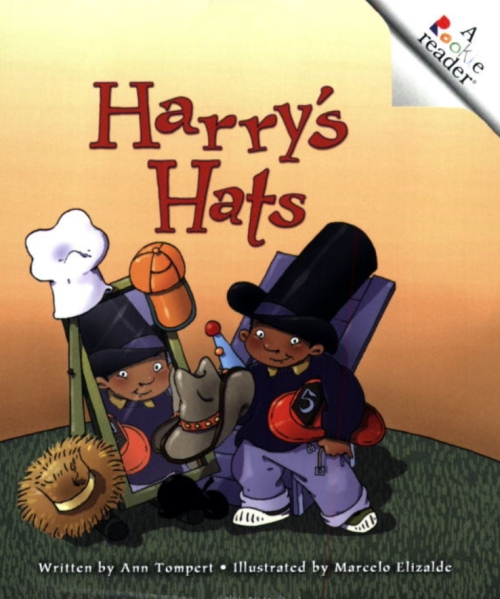
How long have you been interested in art?
I was the “artist” of the family, albeit no one knew what we actually meant by that. It was easy to see that I would drop out from any technical career, which I did.
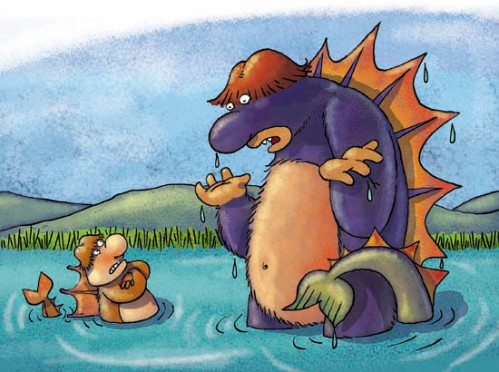
Did you study art in college? If so, what college did you attend and what did you study?
I assisted for less than a year to the Escuela Nacional de Bellas Artes (National School of Fine Arts) in Buenos Aires. In those days the syllabus was very good but rigidly classical, and Illustration was a very, very bad word. Everyone liked what I produced, but it was just illustration or it looked like such. Nobody knew what to answer to the question “So, what?”. I dropped out and went back home to teach myself.

Can you tell us a little bit about the classes you liked?
I liked especially Sculpture and Engraving, partly because the professors were very talented and open minded, and were of the idea, which I learned then, that you must try to master the technique to liberate yourself from material burden as much as possible. Their message was “do what you want, not what you can“. I forgot about Gravure, but Sculpture is still a blissful place where I want to get someday.

What was the first painting or illustration that you did for money?
The very first were a couple of single-panel cartoons for a sailing magazine. They were funny and I still like them.
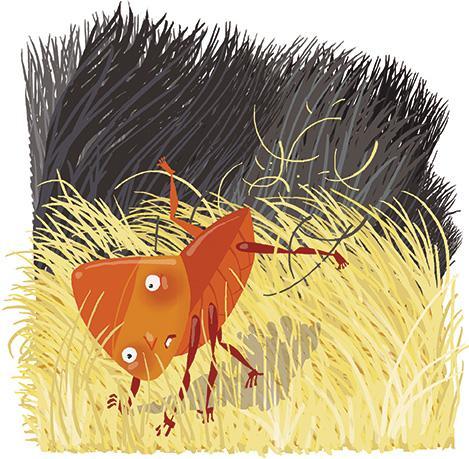
What type of job did you do right after you graduated?
I did not graduate, as I said, and the things that I did one can hardly call them a “job”. My career started out in the wilderness.
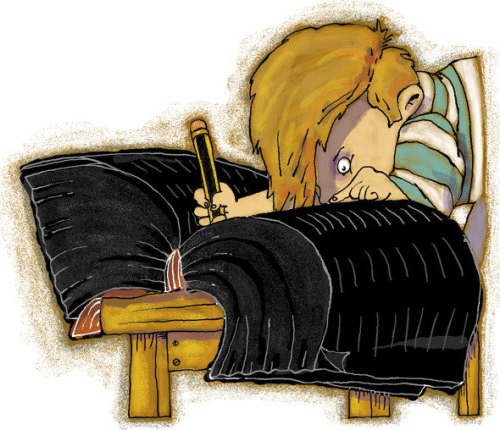
How and why did you start going digital with your art?
In the 90s I contributed to a magazine –that was the dream-come-true of my childhood– and for production reasons they encouraged us illustrators to switch to working with computers. I like gadgets, so I bought a Mac and all the peripherals one Friday, a friend helped me plug everything correctly on Saturday and Monday evening I was giving in my first digital illustration. I felt like I had been illustrating in Photoshop for years and that I could finally perform things that were impossible with traditional materials.
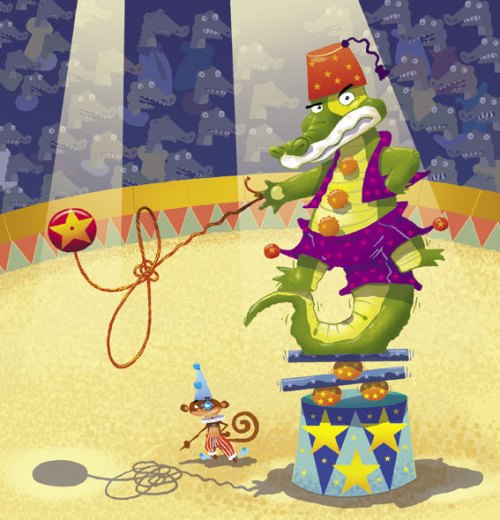
Have you always lived in Argentina?
Yes, except for a 6 month stay at Bogotá, Colombia. I moved with the idea of settling there, availing a publishing boom, but I soon found out that it didn’t smell like books but rather just like paper. That was a vaccine against any will to migrate.

What do you think influenced your artistic style?
I have a straightforward and humorous approach to my subjects, and that I learned from Sergio Aragonés, a Cuban cartoonist that did the little drawings in the corners of Mad magazines. He knew everything about producing funny situations in black and white ink thumbnails. I also learned a lot with Richard Scarry, who conveyed humor and expression to his very simple animal characters. And for the image itself, I always loved and longed for the illustrators of the 50s and 60s, like the Provensens or Celestino Piatti or my compatriot Ayax Barnes, among many others.

What was your first big success in illustrating?
In Colombia I illustrated a cookbook for children produced by Nestlé (the swiss dairy company) to be distributed to supermarkets that sold hundreds of thousands of copies. But this I learned when I was back in Argentina, so nobody even patted my shoulder for that.

When did you decide you wanted to illustrate for the children’s market?
Nearly always, or at least since I was 17. The trouble is that I didn’t know then that that was called illustration and that doing it for children was a specialty in its own right. I always wanted to produce the kind of images that I saw in the books I read.
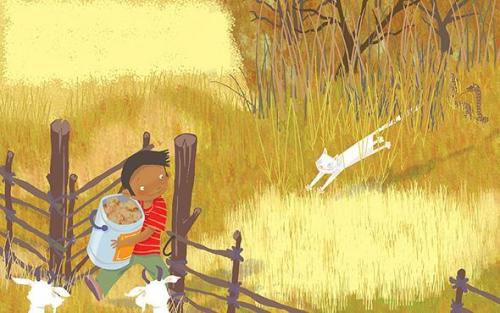
When did you do your the first illustration for children? And what was it?
In a sense, when I was 17, an age that I mentioned before, and it was in the most direct and brutal manner.
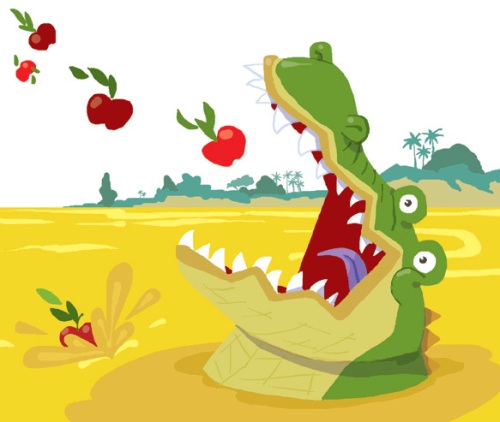
How did that come about?
I assisted to a secondary school where they thoroughly taught us English language, and the last year we had to make teaching practices within the school, to primary pupils. My first assignment was a first grade, Friday afternnon, last hour; the worst possible combination. To make things harder, the teacher was very beautiful and we were all in love with her.
The subject was The Farm. I could neither refuse nor desert so I produced a series of cutout animals and people and farm objects that the little demons had to stick to a big paper with background field and sky. Though I made this up the night before, the lesson was such a success that I could have the children quiet for 15 minutes. The cutouts were much admired and I thought “Where did this all come from? How could I do it out of nothing?” It took me ten more years to find out.
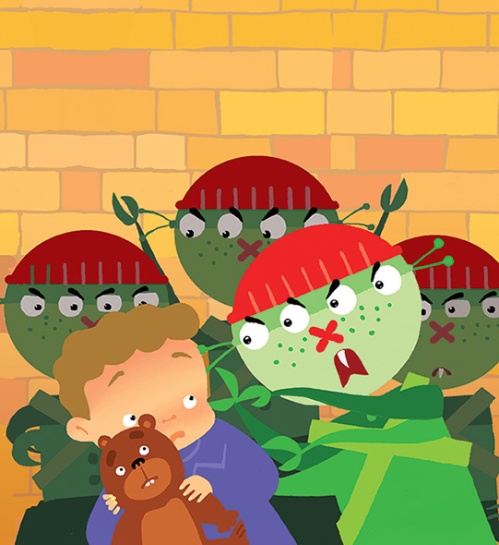
Do you have an agent to represent you? If so how did you connect? If not, would you like one?
I did have one in the UK, but it didn’t work. I would like to have one. There should be agents to get you an agent. An Uberagent.
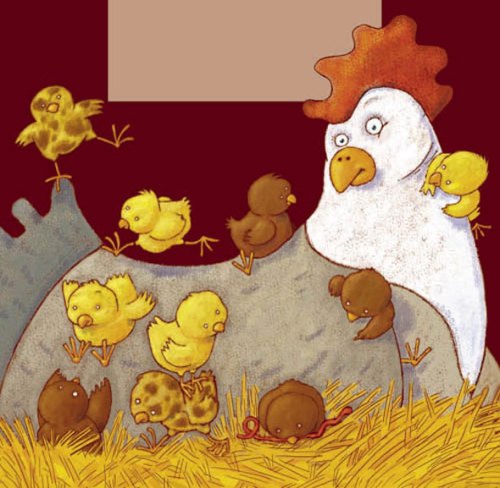
I see a few pictures that look like you sculpted a character. Is this something new you are trying out?
I started that back in 1995, blending my untested talents in sculpture and my profession. I did some works with clay, and I even took my models (yes, the very models) to the Bologna Book Fair in Italy, where I got much praise, but no assignments. The market for such technique is very, very small, as one can see in any bookstore. Anyway, my models availed me interviews at Aardman, the makers of the Wallace and Grommit series, and in the Spitting Image studios, both in the UK.
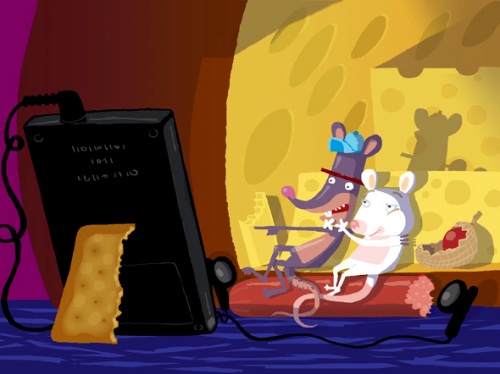
Have you published with any USA publisher? If so, who? And how did you get the contract with them?
I attended the SCBWI’s Winter Conference in 2001, where I made good contacts, particularly with Don Curry at Mondo Publishing, from whom I got my first assignment in the USA. Then came Innovative Kids, MacGraw Hill, Scholastic, Meredith, Klutz, and some more. I was assigned very interesting projects that I enjoyed a lot.
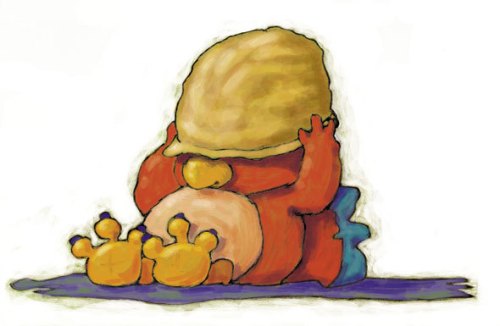
Do you have any desire to write and illustrate your own book?
Oh, yes.
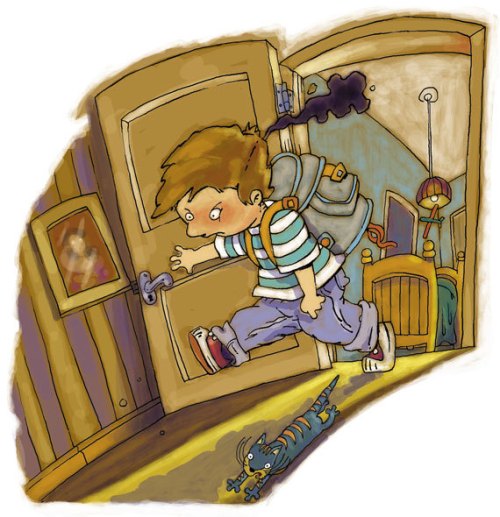
Are you open to illustrating a picture book for a self-published author?
As long as they pay me my fees, yes, why not. I stumble from time to time upon a request of this kind, but I couldn’t so far find out why these authors assume that you will do it for free, for the glory of it or for an uncertain future reward.
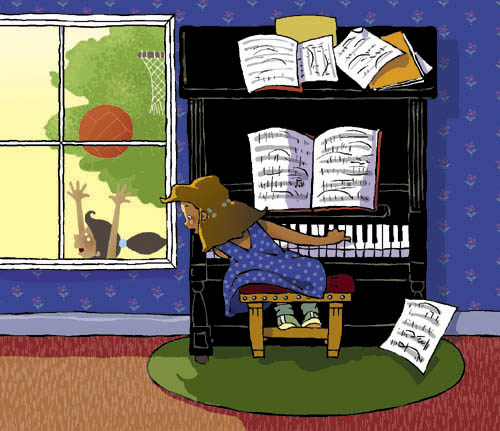
Have you worked with educational publishers?
Yes, and I particularly enjoy illustrating impossible books, like math books, and make of them a thing worth seeing. So much so that educational publishers in Argentina used to call me when they had one of those unillustratable books. This is where I apply what I learned from Sergio Aragonés.

Have you done any illustrating for children’s magazines?
Yes, and I am currently contributing to one. But for many years I illustrated for the magazine that I (and everyone else in Argentina and the region) read when I was a kid. That is a badge that still makes me proud. I also worked for newspapers, both for children and adults. I particularly enjoy this kind of quick, concentrated effort, where you have one or very few shoots to make a story. You have to be very efficient.

What types of things do you do to find illustration work?
My repertoire is a little limited. I have a subscription to Children’s Illustrators, and I mail the news about my recent work to clients. In fact, I concentrate my efforts in keeping my clients rather than go hunting new ones. That’s not for mere conservatism but simply because I don’t have a bold strategy to do otherwise.
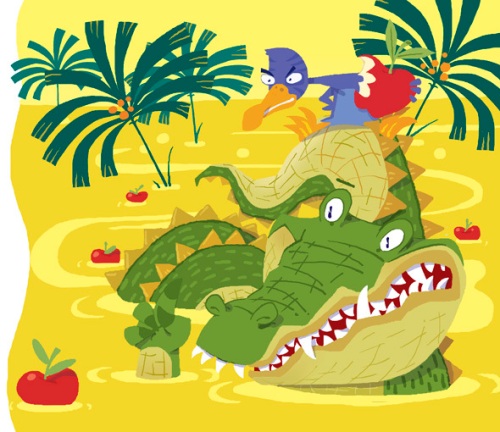
What is your favorite medium to use?
Apart from the computer I love gouache. I started my career with that medium and it made a deep impression in my style. If you look at my pictures you will see that many of them imitate that juxtaposed color planes mode, as if it were gouache. I like the smell of it, too. And I have an unconditional love for the common, old black graphite pencil of eternity.

Has that changed over time?
As I said, I started with gouache, but then I tried everything else. Watercolor, acrylic, color pencils, pen & china ink, crayons and pastels, paper cutouts, plasticine, collage and I even tried baked dough (It didn’t work).
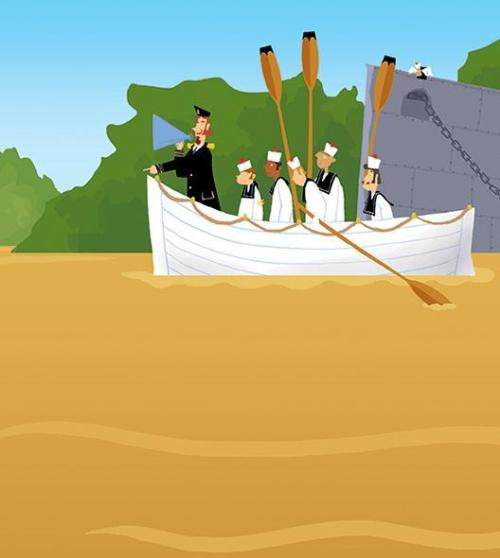
Do you have a studio in your house?
Yes, habitually. Not in this very moment. To have the studio at home is both a blessing and a curse, but I have decided long since that it is much more the former than the latter.
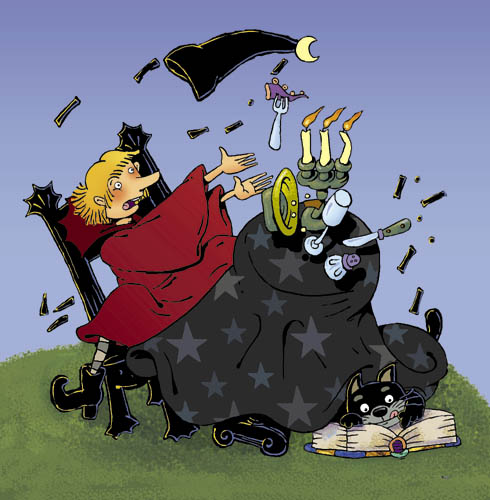
What is the one thing in your studio that you could not live without?
The radio.
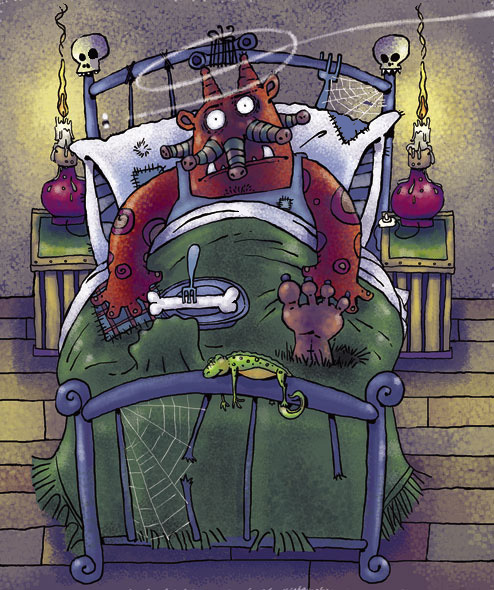
Do you try to spend a specific amount of time working on your craft?
No, I’m not that disciplined. I am a very curious person and i have a lot of interests that claim for their share of my time. I am disciplined to meet deadlines, though. As writer Douglas Adams said, “I love deadlines. I love the whooshing sound they make as they fly by”.
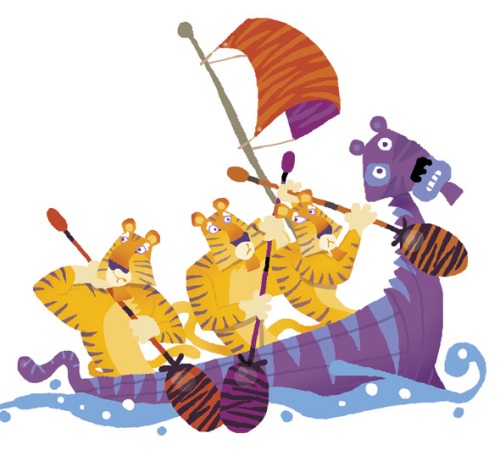
Do you take pictures or do any types of research before you start a project?
Yes, but to a certain point. My style does not support much documentation. It becomes very evident when I stick too much to researched images. Anyway, I do google my subjects, be it a rhinoceros or an airplane, but I usually make it just to avoid horrible mistakes or pick features that will enhance the result.
I have very seldomly taken photographs as documentation. When there was no internet, I used to go to the zoo and take some pictures when I couldn’t find the angles that I needed. Now you type “mouse-deer” and you have loads of photos to choose from.
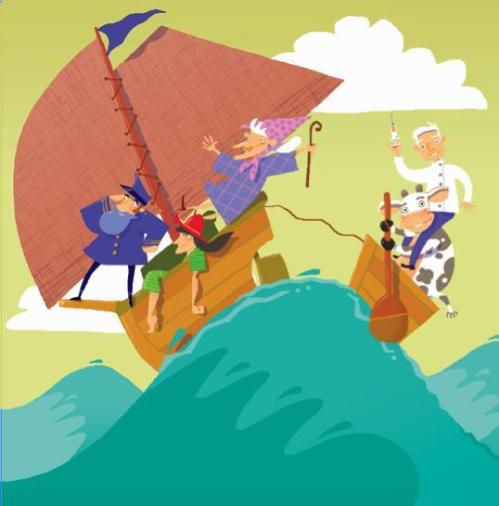
Do you think the Internet has opened doors for you?
Not doors but gates! I could write an essay on the favorable changes that the internet brought to my work. It added extra dimensions to the creative process, the professional life, the research, the relation with colleagues, the access to other illustrator’s work, which was very limited before; the delivery of the pictures, the invoicing, the wiring, the meeting of new people from everywhere. I just cannot remember how it was to finish the work, tidy myself, dress up and go bring it to the editor. Do you remember?

Do you use Photoshop with your illustrations?
Yes. I love it. They made it thinking of me. Anyway, I would love to meet the crew someday and tell them a couple of things!
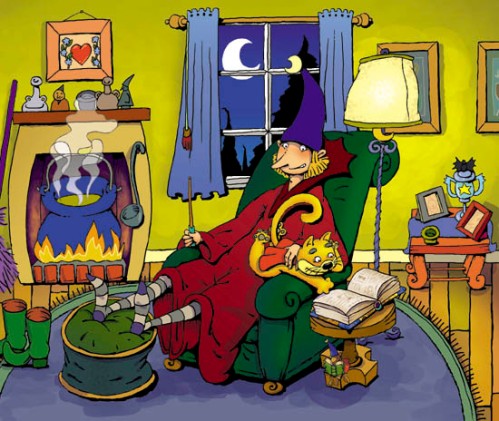
Do you own or have you used a Graphic Drawing Tablet in your illustrating?
After my first month struggling with the mouse, my Mac dealer called me and said “You should try this”.
First comes my right hand, second my Wacom, then my left hand.
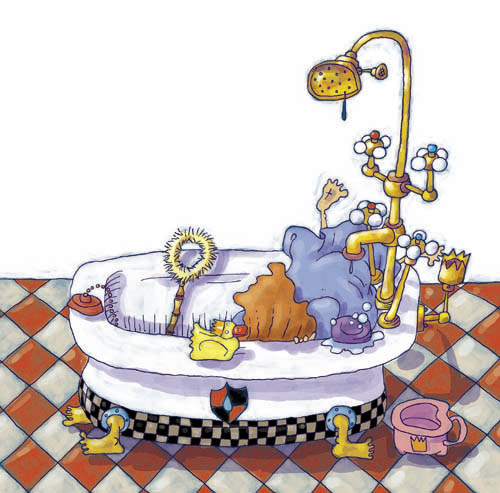
What do you think is your biggest success thus far?
I didn’t have any big successes that I can think of.
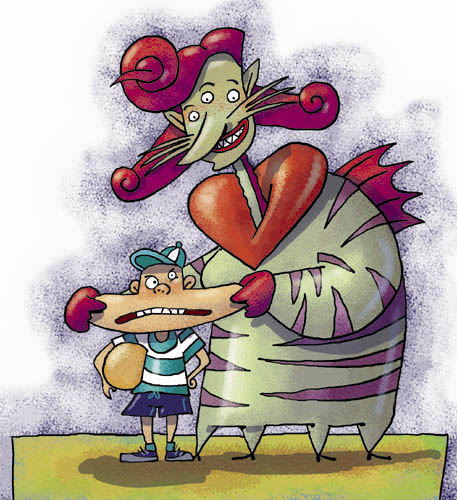
Do you have any career dreams that you want to fulfill?
I am currently finishing the research for a book I want to write about illustrating for children. Not about technique nor professional development, but about the essence of what we do. I want to give an answer to the question “What is it that we do? For what?”. I never heard of a good answer to that. I think that in reality nobody knows. Well, I think that I am slowly coming to the point and I will struggle to publish it. That is my dream.
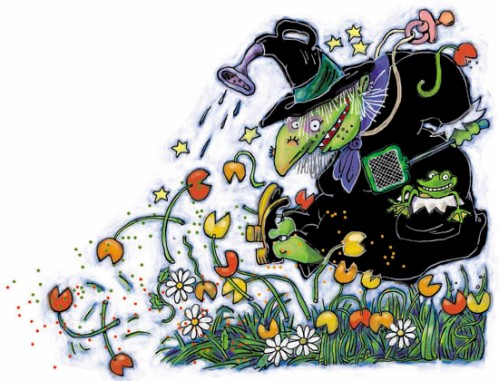
What are you working on now?
I´m illustrating the second batch of a series of books whose translation would be The Jungle Gang, obviously about the adventures of a group of animals. They are coming out funny.
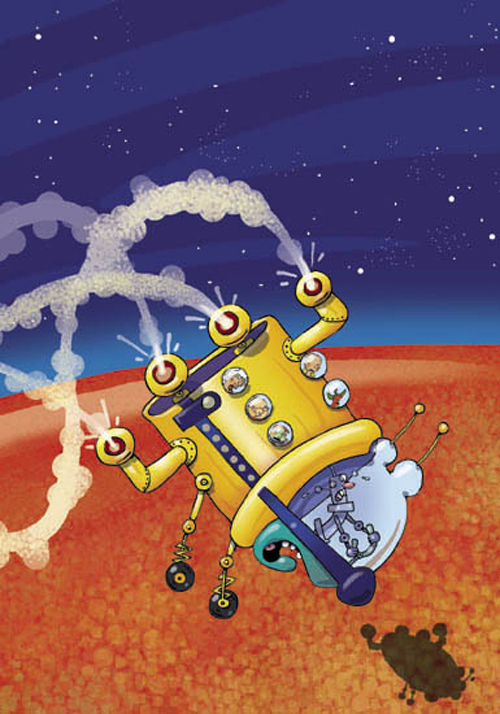
Do you have any material type tips you can share with us? Example: Paint or paper that you love – the best place to buy – a new product that you’ve tried – A how to tip, etc.
Always buy the best material that you can afford. Saving in this matter is like bandaging your fingers, or maybe banging on them.

Any words of wisdom on how to become a successful writer or illustrator?
I use to say that I had to navigate my profession looking at the stars. Now, the young illustrators have their GPSs –the internet is one of them– and there are tons of advice everywhere. But there’s one thing that I try to never forget, and that is the children; the children that see my pictures and incorporate them along with the story, and feed something into their minds, or hearts, or souls. In many parts of the world (not in the USA) the child as a viewer is being neglected and the images are becoming cold and distant, as if intended for adults, more concerned about the aesthetics of the matter than the emotions one has to help express.
To say that I mind the child within me is too commonplace and expresses nothing. I’d rather say that I work for the real, average child out there.
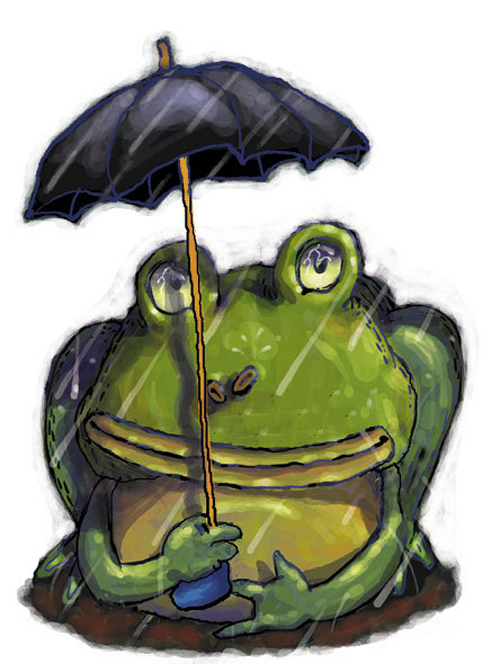
Thank you Marcelo for sharing you process, journey, and expertise with us. I know you will have many more successes in the future and we would love to hear about all of them, so please drop me a line when good things happen.
To see more of Marcelo’s illustrations you can visit him at: www.marceloelizalde.com.ar Please take a minute to leave a comment for Marcelo, I know he would love to heard from you and always appreciate it. Thanks!
Talk tomorrow,
Kathy
Filed under:
Advice,
demystify,
illustrating,
Illustrator's Saturday,
inspiration,
picture books,
Process,
Technology,
Tips Tagged:
Buenos Aires,
Marcelo Elizalde 


By: Kathy Temean,
on 6/11/2014
Blog:
Writing and Illustrating
(
Login to Add to MyJacketFlap)
JacketFlap tags:
Amal Karzai,
Author,
Tips,
reference,
writing,
Advice,
Character,
Process,
revisions,
Sympathetic Characters,
Add a tag
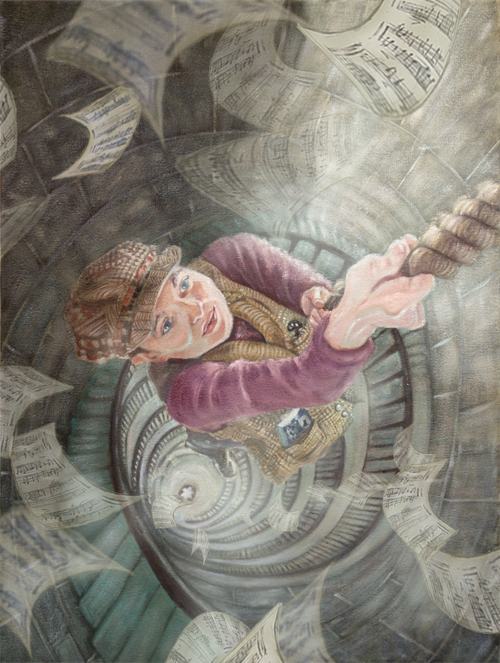
This exciting illustration was sent in by Amal Karzai. Amal was featured on Illustrator Saturday. Here is the Link.
Food for thought:
As writers, one of the questions we ask ourselves when we are reading our first draft is, “Is my main character sympathetic? What we are really asking is, “Have I written a character that the reader will want to root for?” “Will the reader feel what your character feels?” Will the reader understand the difficulties that face the MC and will the care?”
The goal is to create the fictive dream, to immerse the reader into the story’s world, but if we make our protagonist too snarky or whiny, even if they will grow during the book, the reader may not want to spend their time with the little brat and put down your book. You need to give the reader a glimpse of some redeeming quality. The MC could be in the middle of a meltdown, but the writer could show the MC unconsciously doing something nice during that scene. It could be as little as just stopping a glass of juice from falling off the table or keeping their little brother from slipping on the juice that has spread across the floor. By doing this you have shown the reader something good about the character and given them a reason to want to stay on the journey with him or her.
Just be careful not to go too much the other direction. If your MC is too perfect, the reader probably will not like him or her. Making your protagonist too perfect will make it almost impossible for reader to identify with them. Plus, it does not give the MC any room for a character arc and no need to grow and change. There needs to be flaws that the character can overcome.
The problem is not to go overboard. No one wants to read about a stupid person. No one wants to read about a major sad sack. Award winning author, Alicia Rasley says, “A passive victim doesn’t struggle – just suffers,” and “Defeat isn’t sympathetic. It’s pathetic.”
There are many ways to create sympathy for your characters, but just try to keep it fresh. Use a combination of strengths, struggles, and sacrifices. There are outer strengths, like physical and skills, and there are inner strengths, like perseverance, self-control, optimism, wit or humor, and integrity. Try to avoid old tired troupes.
Remember, you can show your character as lonely, disadvantaged, unpopular, unfulfilled, sad, and confused, but the reader doesn’t have to pity the character to identify with him.
Do you have any “food for thought” to add, that might help create a sympathetic character, while not making them feel stale? Any tips on making your characters interesting and someone the reader would like to spend time getting to know? We’d love to hear.
Talk tomorrow,
Kathy
Filed under:
Advice,
Author,
Character,
Process,
reference,
revisions,
Tips,
writing Tagged:
Amal Karzai,
Sympathetic Characters 

Our minds are experts in construction. They will build up fences quicker than nobody’s business. It’s actually a survival method, the brain ‘thinks’ it’s looking after our best interest, keeping us safe by setting limits.
The problem is that this survival method is archaic and antiquated, most of the fence-building is stopping us from pushing ourselves in work or running rather than stopping us from trekking too far from our caves, getting lost, and gobbled up by a dinosaur. 

In breaking down your fences you are freeing yourself. Because on the other side, THAT is where you can push yourself to your best. The other problem with fences is that they stop you from even dreaming, or imaging that something epic is ‘out there’ that YOU could possible accomplish THAT! Fences keep you safe, in a comfort zone, they also suck because they rob you of really feeling and experiencing.
We can easily relate this to running in a few ways:
1) Goals: if your goals aren’t big enough to scare you a bit, they should be bigger. That said, you should know that working towards something BIG is HARD. That’s the point, that’s what makes an accomplishment fulfilling though. Just don’t be fooled into thinking there won’t be times where you want to stop…that’s where true self-motivation and dedication is tested.
2) Going in over your head: everyone needs to be in the position of going in over their head, a few times, and get comfortable with the fact that, “Yea, I might bonk” because, “Yea, I might not bonk and break through to a new level.” There are times in races where you need to not look at the clock/watch/split and just race, get swept up in the faster group…this can be in workouts too.
Confidence is a funny thing for a runner, and the watch can do wonders for it but it can also sabotage you if you ‘think’ about it too much. Example: “Holy crap!!! We’re running XXX pace, I can’t hold this…what am I doing running with these people, I don’t belong here?!!” This runner can either be intimidated by the splits or check in with themselves and realize they were actually feeling fine until they freaked themselves out. They might blow up later, but they may not, they may have their best workout yet. Either way though, sometimes you need to just stick your neck out there, break the fence.
Important to note that, duh, you shouldn’t always go on some kamikaze mission in workouts and races. I mean, a 7 minute miler shouldn’t go workout with the 4 minute miler group…let’s be sane here. The point is that for the most part, runners DO need a little push every now and again to break through to the next level. Surrounding yourself by some faster people is a great way to do that.

3) Mental ‘fences’ pain signals: for runners the vast majority of fence building is stationed around hard workouts and races. Your brain wants to STOP pretty much the second you start…haha. Steve Magness wrote a really great post all about the brain, willpower, emotions, and how that relates to a runner’s mental toughness. It’s a long read but incredibly interesting, worth it, and touches on quite a few different points, tackling it from multiple angles.
He talks a lot about willpower and how fatigue is actually an emotional response rather than a physical one. Really interesting because when you think you’re ‘tired’ it’s really only your brain reacting, worrying that you’re GOING to be too tired later to finish and shouldn’t continue. He goes on with lots of ways a runner’s willpower and mental toughness to combat the pain signals from the brain are affected. Things that make us more easily swayed to stop rather than push.
Proper recovery like nutrition and sleep are two factors…another reason to think of your training in the big picture sense. But another big mental toughness inhibitor is stress. He phrases it more as using your willpower reserves up on less important matters, but the explanation is that your brain can really only handle so much. The more taxed your brain is going into a workout or race, the less it will perform. Read as: the weaker it goes into the race, the more likely you are to cave to its complaints to relent, slow down, or stop.
Go read his full article HERE because really, there’s so many interesting points that make you think. A runner’s mental toughness is something most all of us are fixated on because it’s not finite, it’s kind of like an intangible that’s hard to explain with science. But Magness is actually able to show how science is closing in on giving us some cool explanations and theories.
The bottom line is: Runners, scr*w those fences. Start breaking them down and in doing so you’ll find that’s where the truly epic sh*t lies.
——-
More posts on MOTIVATION
——-


Hey everyone ,
Leaving art college or university can be both an exciting and nerve wrecking time for the upcoming graduate. Whether your in art college or university here in the uk or internationally and are ready to pursue your creative career its always best I think to plan and prepare before the big leap.
I remember when I graduated from my bachelor’s degree I thought everything would be plain sailing, though when you actually leave you realise how that bit of planning can help in being efficient and organised in working towards your creative goals and knowing what to do next. So to lend a hand I’ve put together 5 tip on what to do before you graduate in 2014 for pursuit in a creative career.
1. Research : If you know in yourself that your next step is to venture into creative freelancing in your specialism then the best thing to do is gather your research. Looking into things such as freelancing rates, how to register your business, potential business funding or scheme’s available in your area may just help you plan out what course you need to take to do what you love.
2. Prepare your portfolio: The key thing thats going to help skyrocket your creative career is your portfolio and the work you have in it. Now having completed your years of degree or college work you’ll no doubt have a portfolio full of lovely projects. However if like me you came away with dust covered dissertations and little of a portfolio you may feel abit daunting knowing there’s more work to do.
So whether your portfolio is ready or not you need to have it professionally presented for people to view it such as potential clients, agents etc. If your wanting to build up your portfolio from scratch then ideally allocate yourself maybe 3-6 months to build it up to have some fresh new material that your truly happy to promote and using themes like those found here on illustration friday maybe a great place to start generating idea’s.
3. Set money aside : If you’re able to its always a good thing to put money aside to later on use to invest in your business. This will enable you to buy the necessary start up equipment and materials that you need to effectively do the work to a standard that will enable your creative business to function.
4. Gain advice and mentoring : Starting out your own creative venture isn’t easy so I feel that gaining all the support, advice and mentoring that you can will be worth its weight in gold. If you don’t already know what a mentor is or have one a mentor is somebody who can be in your field of practice with experience of the industry who is there to give you advice and guidance to help you along the way now and then.
I am lucky enough to have two wonderful mentors so my advice would be asking someone who inspires you but also who you have established a relationship with whether they would possibly consider mentoring you. Either way mentoring isn’t all take, no doubt you’ll have skills and advice you can exchange so its a win win situation either way.
There’s also a variety of business support and advice centres locally no doubt aswell as online for you to access such as enterprise nation, the design trust and the princes trust so please check them out.
Hope you found this little post helpful, kudos to you for getting through all your studies and here’s to a creative venture yet to start! Have you decided where you’re venturing on from here?
Image : “Do more of what makes you happy” illustration by Lindsay at Unraveled design .

By: Kathy Temean,
on 6/6/2014
Blog:
Writing and Illustrating
(
Login to Add to MyJacketFlap)
JacketFlap tags:
Tips,
inspiration,
Advice,
Process,
illustrating,
authors and illustrators,
Illustrator's Saturday,
HarperCollins Childrens,
AW NUTS!,
Comics/cartoons,
Rob McClurkan,
Add a tag

 Rob McClurkan grew up in Nashville, Tennessee and spent many happy summers visiting his grandparents on their farms.
Rob McClurkan grew up in Nashville, Tennessee and spent many happy summers visiting his grandparents on their farms.
In college, Rob studied graphic design. Upon graduation he moved to Atlanta, Georgia where he got his first job at an in-house art department. After several years of job hopping Rob, settled in at a non-profit that gave him a children’s magazine to art direct. This gave him the drive to build a portfolio and eventually work as a full time illustrator. Rob has worked with HarperCollins, Scholastic, Usbourne, American Greetings, Highlights for Children. Rob’s first picture book Aw, Nuts! The nutty adventure of a squirrel in pursuit of the perfect acorn is in stores Aug 26.
Here is Rob explaining his process:

Step 1: I always start with a sketch that I create in sketchbook pro. Sketchbook has been a big time saver for me. I can sketch without having to scan the image in and it saves on paper too. Sketchbook pro offers a desktop version and a version for the iPad so you can sketch on the go.

Step 2: I like to start with the main character. I feel like it sets the tone for the illustration. If I get it right the rest seems to fall into place.
I enjoy using texture but I try not to over use it. Here I used a brush to add a little texture under the runners eyes. The rosy cheeks and red nose with highlight adds a little more interest to the characters face.
Step 3: Next I colored the ground. I always struggle how I want to deal with the ground especially when it is grass. Here I just decided to add interest by using a gradient.
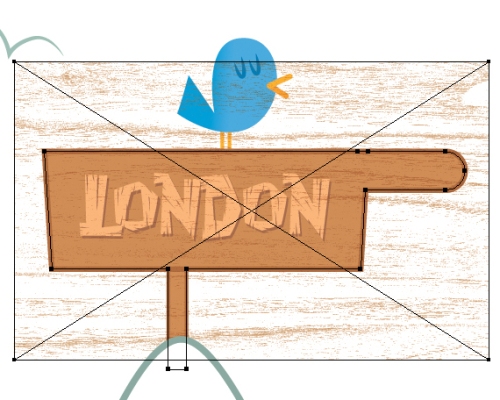
Step 4: I then move to the smaller characters and elements of the image. Here I took a wood texture that I had in photoshop and brought it into illustrator.
The wood texture was originally a black and white wood texture but when saved as a tiff, you can change the black color to any color you need in illustrator by choosing a swatch.
I then create the shape I want for the wood sign and use a clipping mask so that you only see the wood grain in the wood sign.
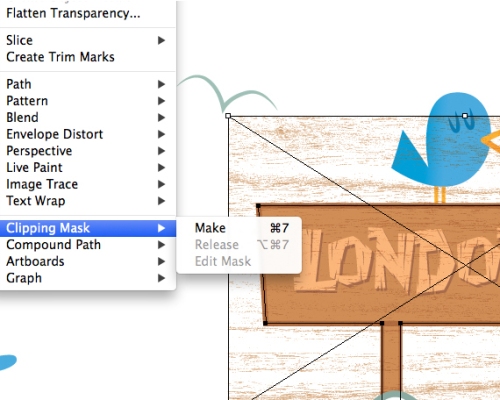
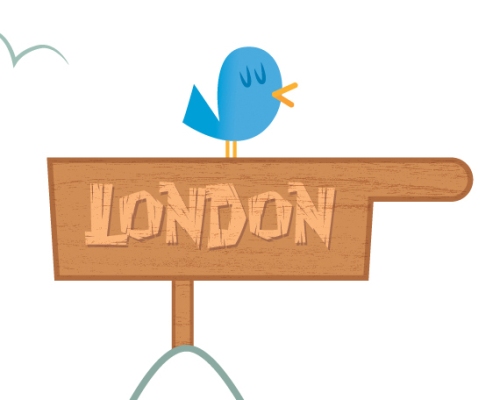
The final result of the mask a fun little wood sign complete with wood grain.

Step 5 : Next I add the other elements in the mid ground as well as the background color.

Step 6: I waited until I had the background to add these buildings. I was not sure how I was going to solve them but once I had the background color I really liked the effect of the buildings fading into the background as if there was a ground fog.
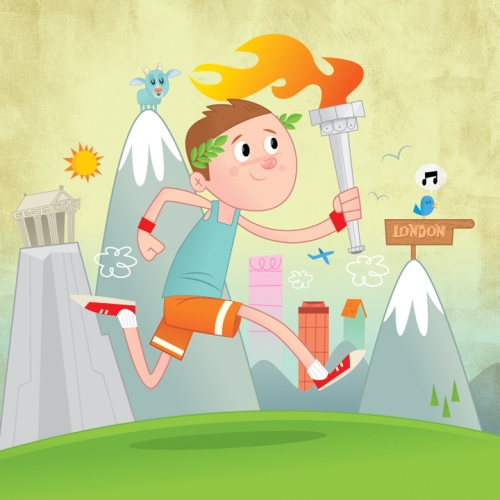
Step 7: I created a texture using photoshop brushes and brought it into illustrator the same way as I did the texture in for the wooden sign.
I never want to overdo texture so I limited my use of it since I knew I was going to use it in a big way in the background.
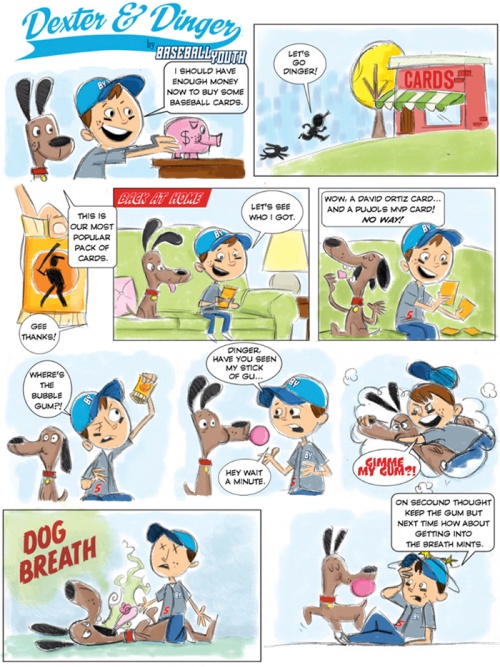
How long have you been interested in art?
I can’t remember a time when I didn’t enjoy drawing and creating my own characters.
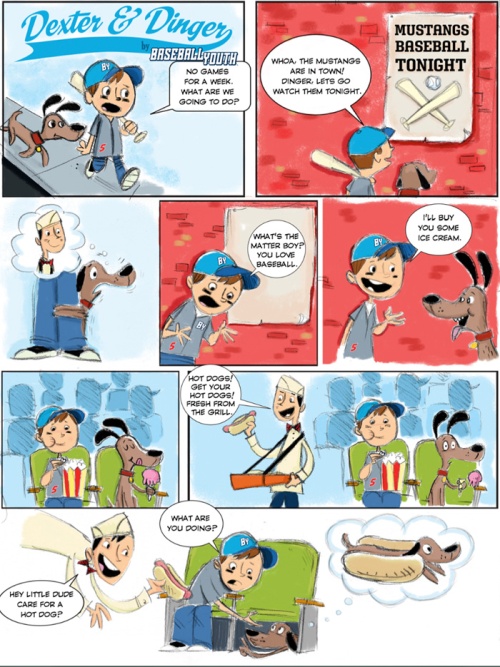
Did you study art in college? If so, what college did you attend and what did you study?
I attended Samford University in Birmingham, Alabama. I studied graphic design.

Can you tell us a little bit about the classes you liked?
The classes I liked were geared toward concept, design, layout and typography. I am a big fan of type I just don’t think I am particularly good with it. I took a class on cartooning and comic strips that I loved. After the class I started submitting cartoons to magazines and created a comic strip for the school paper.

What was the first painting or illustration that you did for money?
Barbie Magazine I did an activity scene in watercolor.

What type of job did you do right after you graduated?
My first job out of college was the world’s worst waiter. I thought I was doing a good job but one of my customers didn’t think so. My first design job out of college was working for a wholesaler of RV parts and anything that goes along with the RV lifestyle. I had to design a weekly marketing mailer that RV retailers would use in their stores. The mailers were similar to the Sunday circulars that are in the Sunday paper. My claim to fame was removing the foot from a camping toilet that you flush with your foot. This was before layers in photoshop. That took mad skills. ;)
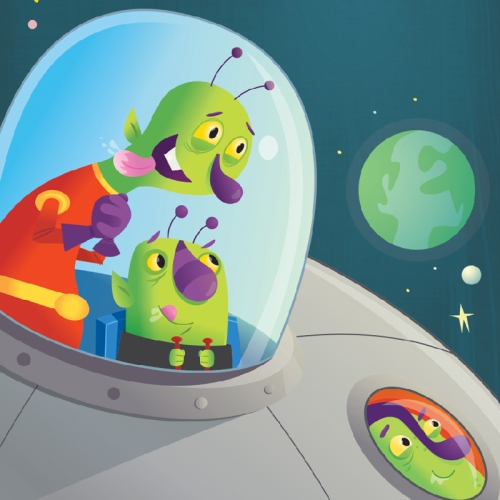
How did you get involved in Advertising art?
I landed a job at a small advertising agency. I think I knew someone that knew someone. They did newspaper ads which were similar to what I did for my first design job. There were a few illustration opportunities as well.
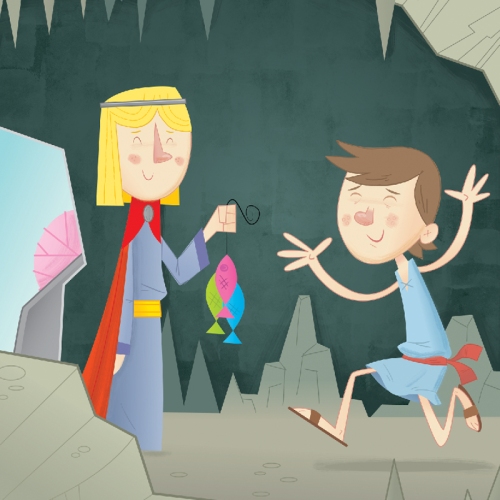
Did you have to leave Tennessee to find opportunities in commercial art?
No – I followed a girl that I eventually convinced to be my wife.
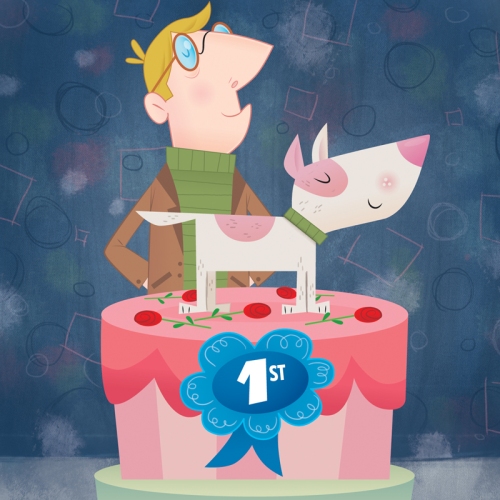
What do you think influenced your artistic style?
My biggest influence I would have to say was the Sunday Funnies. I loved reading them and the art seemed accessible. I felt like I could draw those characters. Saturday morning cartoons were a big influence as well. Any other day of the week I was not a morning person but on Saturday I was up by 5:30 watching the pre-cartoon show which was “Farm Digest” with Murray Miles. I thought that 30min show would never end.

I see that you have done greeting cards. Do you still do them?
Or was this something you did only early on in your career? Greeting cards are so much fun to do. I still enjoy working on them. I have some that I want to show in my portfolio so badly, but they have not been released yet. Greeting cards are like comic strips quick reads and funny. Sometimes I buy a card just because the art is awesome and they make me laugh.
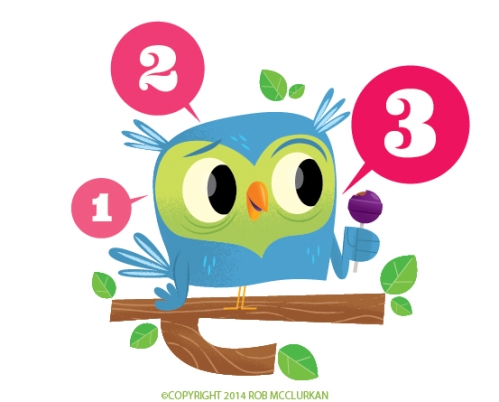
What was your first big success in illustrating?
Being able to quit my day job and illustrate full time. That was a huge step.
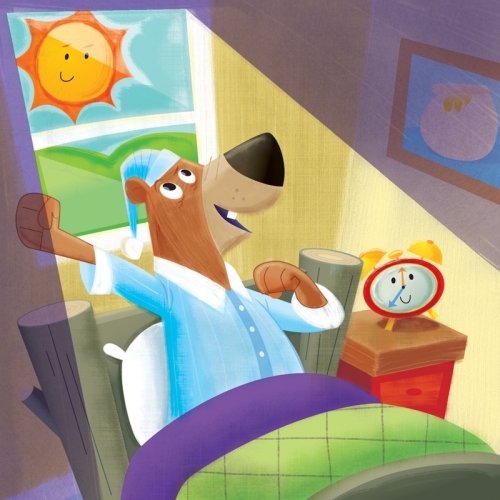
When did you decide you wanted to illustrate for the children’s market?
Early on. I ended up at a non-profit that had 2 kids magazines, and they gave me one of them to art direct. Budgets were tight and so I would hire out some illustrations and then do some on my own. That was a great time of learning because I tried different mediums traditional and digital. I also couldn’t believe I was getting paid to draw.
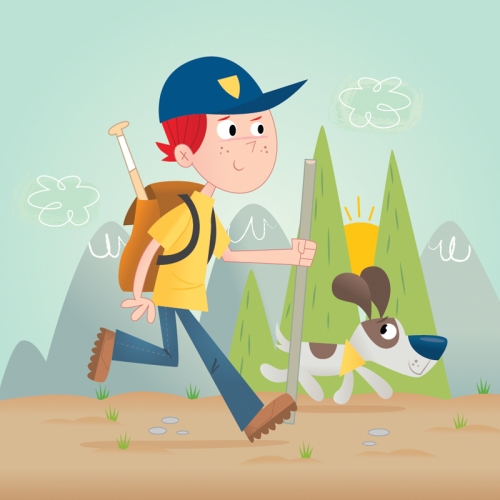
When did you do your the first illustration for children?
My first illustration for children was the Barbie magazine I mentioned above.

How did that come about?
One of my best friends from high school lived in New York. At the time, he was a designer at Marvel comics. I was surprised to learn they also created Barbie Magazine. He knew I wanted to be an illustrator so he thought of me for the job. I think I redrew that image 5 or 6 times trying to get it right. It was my first illustration job and I was very nervous.
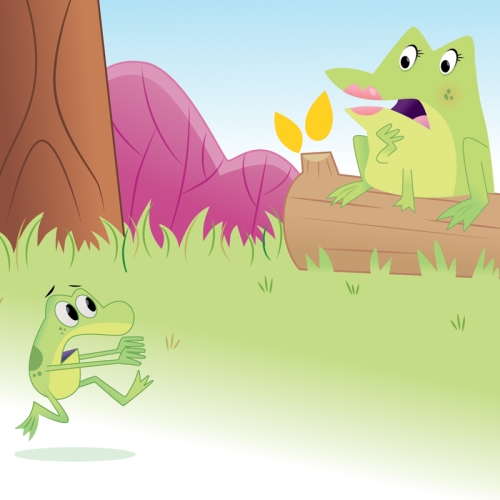
Do you have an agent to represent you?
If so how did you connect? If not, would you like one? I do have an agent. I am with the Bright Agency. An artist friend recommended them. About the same time I realized that Bright’s New York agent was following me on twitter. Once I connected those dots I just direct messaged her through twitter.
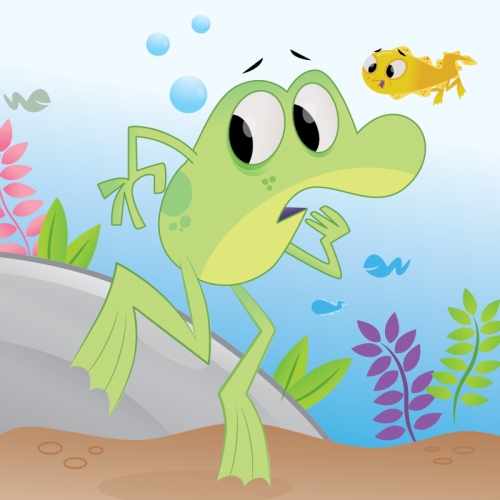
How did you get the opportunity to do the WHAT TO DOODLE? Activity Books with Dover Publishing?
I sent out postcards within a day or two of mailing them out Dover called, referenced the postcard and wanted me to do the doodle book. That’s my plug for direct mail. It’s very effective.

Is AW, NUTS coming out in August with HarperCollins you first picture book?
I have illustrated a couple of short run books in the UK and some Bible story books here in the U.S. but “Aw, Nuts!” is the first picture book I have written and illustrated.

How did that contract come about?
It was actually sort of a happy accident. My agent was pitching another story and the publisher mentioned they would be interested in a board book about color. They were not necessarily asking me to write a book it was just mentioned in passing. That was on a Thursday. I wrote Aw, Nuts! over the weekend and sent it to my agent as a dummy book on Monday morning. In the end, I really saw “Aw, Nuts!” as a picture book so I dropped the color idea and reworked the story and then HarperCollins came along.

How long were you trying to get a picture book opportunity?
I had toyed around with writing and illustrating my own book for several years, but the bug really bit when I attended the 2013 SCBWI Winter Conference. Mark Teague and Mo Willems both spoke that weekend and if I remember correctly encouraged the artist to write their own stories. Their speeches fired me up.
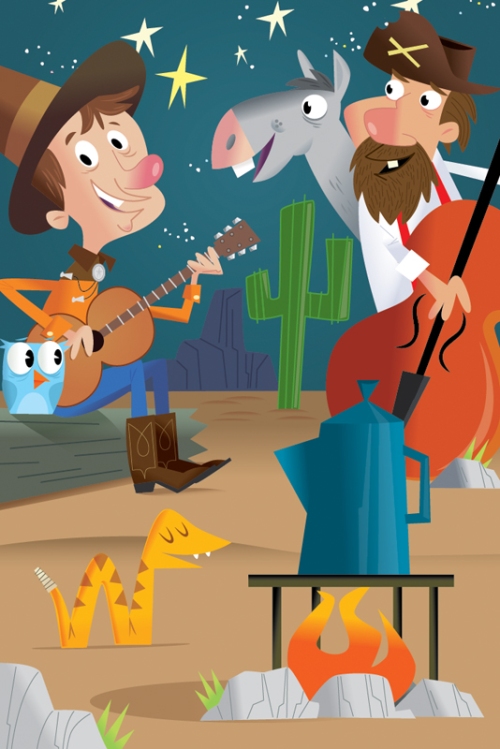
Do you have any desire to write and illustrate your own book?
I have another book right now we are pitching and others ideas I am noodling with.
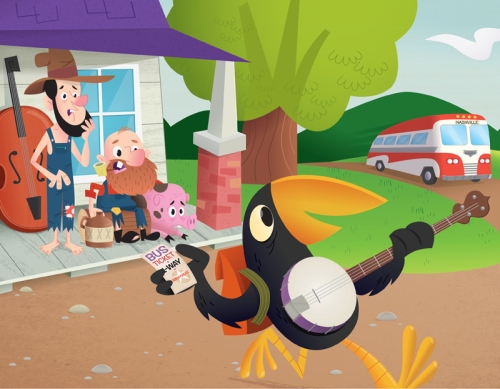
Are you open to illustrating a self-published book?
I may be in the future at the moment I am focusing on working with publishers.
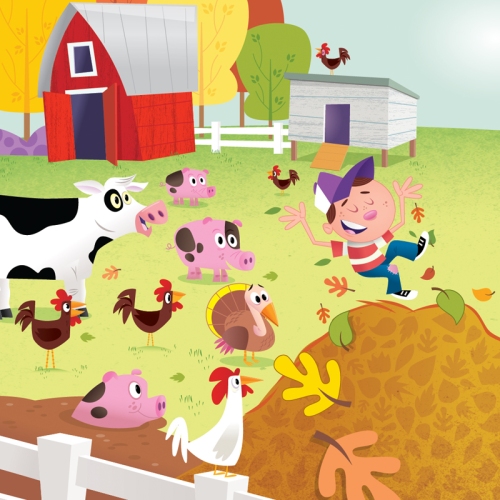
Have you worked with educational publishers?
I have. I really enjoy working with education publishers. My wife is an elementary teacher and if I am not careful she steals my printed samples.
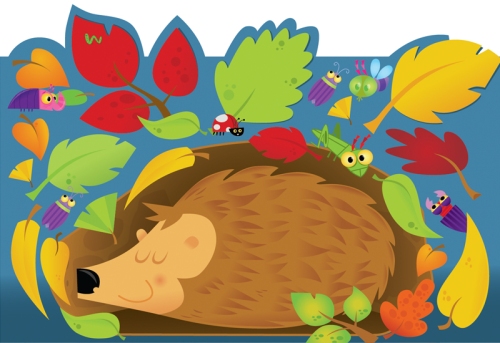
Have you done any illustrating for children’s magazines?
I do. That is how I got my start so I always enjoy working on an editorial piece.
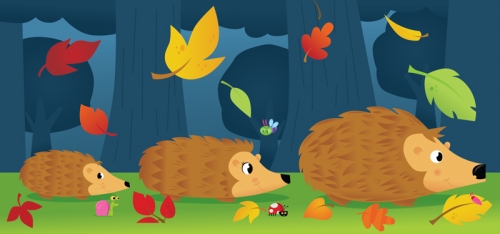
What types of things do you do to find illustration work?
My agent helps a great deal, but I also use direct mail and I am on a few websites. Dribble.com has been a fun way to connect with artist and get jobs at the same time.
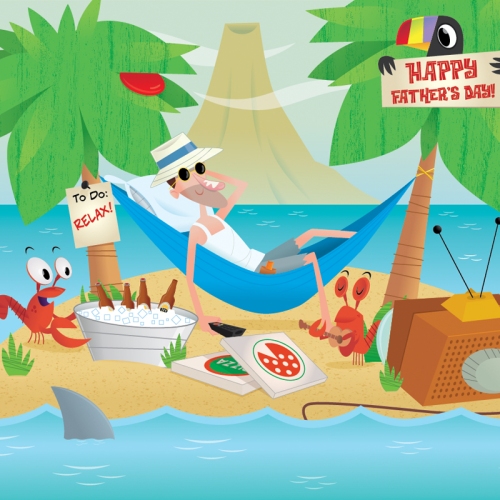
What is your favorite medium to use?
I work digitally, but for fun I like pen and ink. I am also planning on pulling out my watercolors this summer.

Has that changed over time?
Digital has always been the way I preferred to work. I like the idea that I can easily rework a piece if I need to and send to the client without scanning or dealing overnighting a project.
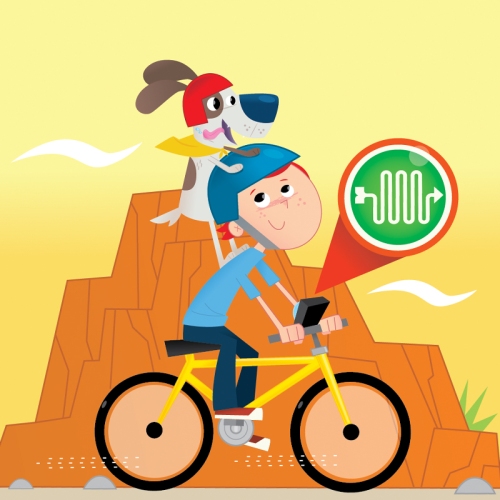
Do you have a studio in your house?
I do. I call it a studio everyone else calls it a basement.

What is the one thing in your studio that you could not live without?
Windows. In our old house my studio was tucked away in a room with no windows. I was so excited when I actually got a studio with a view.
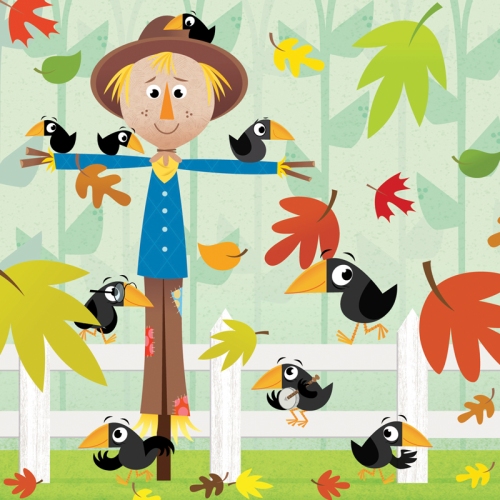
Do you try to spend a specific amount of time working on your craft?
I am constantly writing and sketching ideas, visiting the library, bookstores and toy stores. I also throw ideas out to my kids and wife. She loves picture books as much as I do. She is a great to brainstorm with.
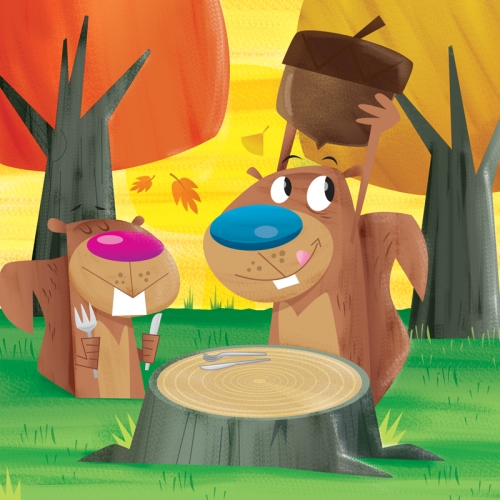
Do you take pictures or do any types of research before you start a project?
I rarely take pictures for research. I used to keep magazines or cut things out that I thought would be an excellent reference. Now I use pinterest. My boards are research, inspiration or image boards for ideas I have brewing.
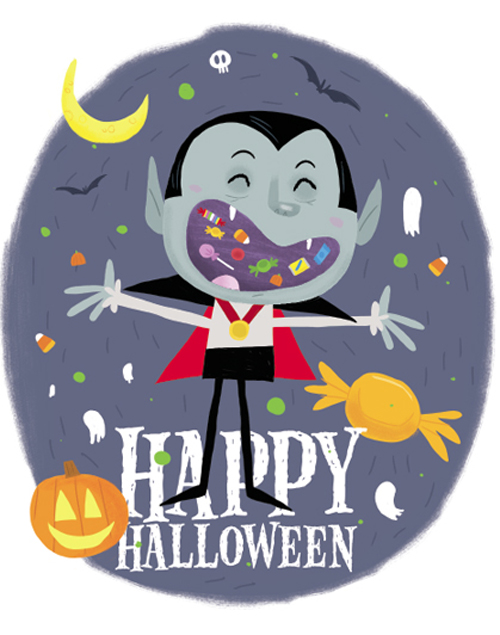
Do you think the Internet has opened doors for you?
Yes, especially social media. It has been a great way to connect with other artist, clients and agents.

Do you use Photoshop with your illustrations?
For a long time I mainly used Illustrator but I am starting to work in photoshop.
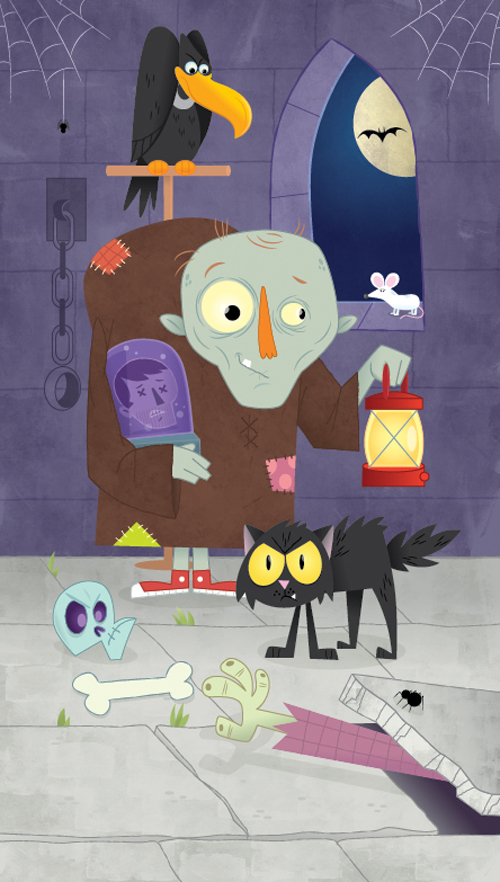
Do you own or have you used a Graphic Drawing Tablet in your illustrating?
Yes, that is another thing in my office I can’t live without. I have a Wacom Cintiq that I use for sketching and Photoshop and an intuos that I use when in Illustrator. Those tablets are tools of the trade that I have to have.
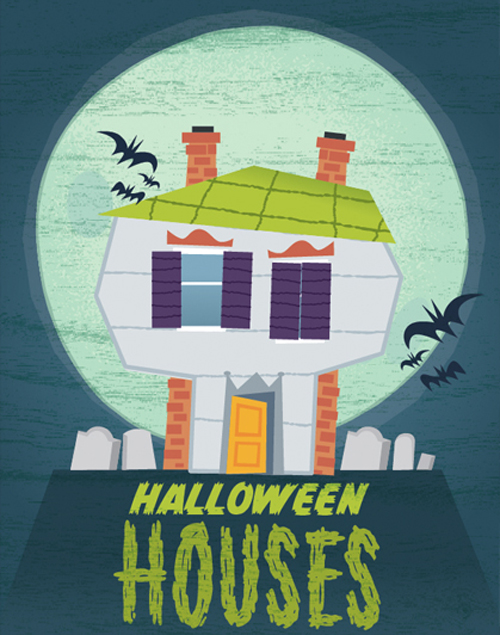
What do you think is your biggest success thus far?
“Aw, Nuts!” is by far the biggest. I am so excited for the book’s release. I had the opportunity to share the book at my wife’s school and the kids loved it! Seeing how they responded to the book was probably the biggest reward. My new favorite thing is the letters I received from the children after the visit. The other really cool job I got to do was creating the packaging for a toy that Mattel gave to John Lassiter as a gift. The toy was a John Lassiter action figure/doll the packaging was inspired by the fact that he wears lots of Hawaiian shirt. I had to create pixar characters as tiki idols. I never knew what happened to the toy, but I always imagined it in his office. One night I was watching a documentary on Pixar and sure enough at the end of the show they showed a zoomed in shot of the toy and I can just make out some of my art. That is the 2nd coolest job I ever worked on.
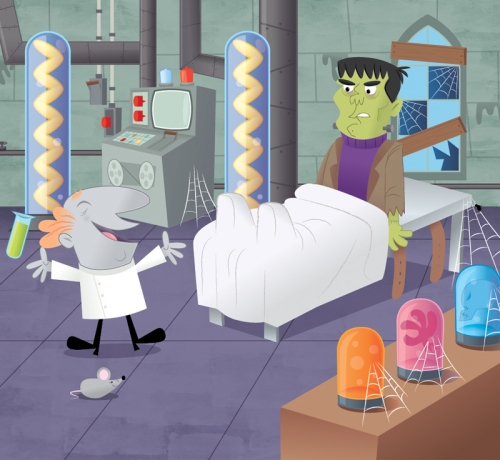
Do you have any career dreams that you want to fulfill?
I would like to continue writing and drawing my own books and would love to work on chapter books.

What are you working on now?
I have a couple of story ideas brewing. I am also trying out a new style. I don’t want to be just the Adobe Illustrator guy. Aw, Nuts! was the first thing I have worked on where I didn’t use Adobe illustrator. I enjoy pushing myself and moving beyond my comfort zone, which at the moment is Adobe Illustrator.

Do you have any material type tips you can share with us? Example: Paint or paper that you love – the best place to buy – a new product that you’ve tried – A how to tip, etc.
My biggest tip is to connect with other writers and illustrators. I have learned a ton from just listening or asking questions. If you can join a crit group they can be super helpful.

Any words of wisdom on how to become a successful writer or illustrator?
For me it has been as simple as read a lot and draw everyday. Quit dreaming and start doing.
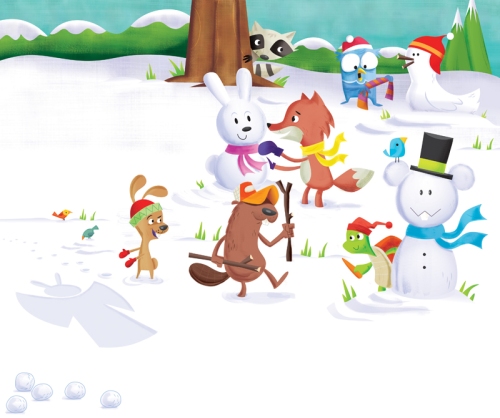
Thank you Rob for sharing you process, journey, and expertise with us. I know you will have many more successes in the future and we would love to hear about all of them, so please drop me a line when good things happen.
To see more of Rob’s illustrations you can visit him at: http://seerobdraw.com/ Please take a minute to leave a comment for Rob, I am sure he would love to heard from you and it always makes me feel like Illustrator Saturday should continue. Thanks!
Talk tomorrow,
Kathy
Filed under:
Advice,
authors and illustrators,
illustrating,
Illustrator's Saturday,
inspiration,
Process,
Tips Tagged:
AW NUTS!,
Comics/cartoons,
HarperCollins Childrens,
Rob McClurkan 

Runners, be you vegan or not, you should get friendly with our friend, Kale. 
This video was posted on my Instagram page, so if those 15 seconds left your eyes darting to read all the awesome Kale facts, let me run through them again for you:
* Iron
* Calcium
* Vitamin B6, A, C, and K
* Chockfull of antioxidants
* Fights inflammation
So yea, Kale really is hip. Without the skinny jeans. 
———–
More posts on NUTRITION
Post all about the importance of IRON
More foods that FIGHT INFLAMMATION
More CARTOONAGE 
———–


By: Kathy Temean,
on 5/30/2014
Blog:
Writing and Illustrating
(
Login to Add to MyJacketFlap)
JacketFlap tags:
Iggy Loomis,
Lord Sterling Literistic in NYC,
Tips,
inspiration,
Advice,
Process,
Scholastic,
Mike Moran,
Illustrator's Saturday,
Erica Silverman,
Add a tag
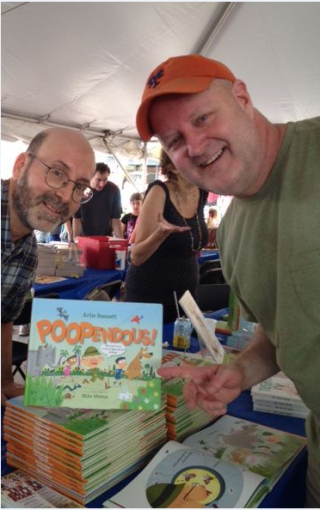 Mike Moran is a New Jersey based artist and children’s book illustrator. “Are We There Yet?” is a peek into his humorous world of zombies, down and out mice, sea creatures and more. His work is presented through a variety of mediums from wooden sculptures to prints on bullet-proof glass.
Mike Moran is a New Jersey based artist and children’s book illustrator. “Are We There Yet?” is a peek into his humorous world of zombies, down and out mice, sea creatures and more. His work is presented through a variety of mediums from wooden sculptures to prints on bullet-proof glass.
Over the years Mike has worked for some really fun clients like: Major League Baseball, The Grammys, Scholastic INC., Disney, American Greetings, Dial Books, Penguin Books, Harper Collins, Blue Apple Books, Highlights for Children, MasterCard, New York TImes and many more. One day he hopes to play first base for the New York Mets and be a songwriter in Nashville!
Here is Mike explaining his process:
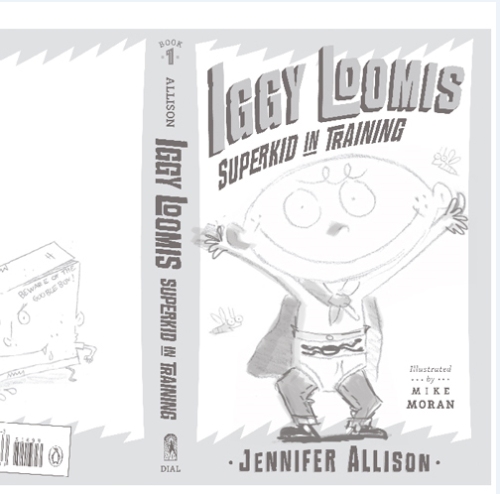
1) I still do my sketches with pencil on tracing paper. The Art director for Dial sent me a PDF of my sketch in layout form.
I placed it in an illustrator file then made it a template. I then added a new layer to start working on.
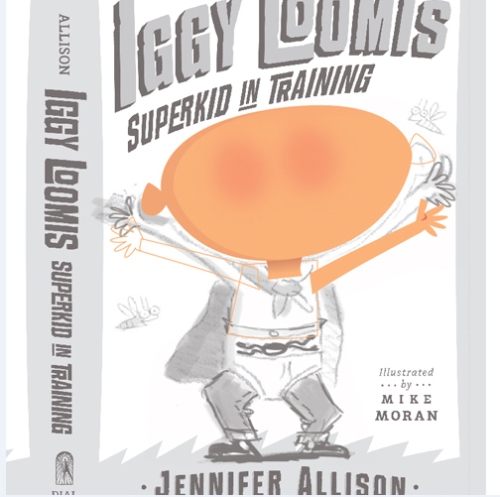
2) With the pen I start to go over my sketch with a stroke lining out shapes. I don’t work in the outline setting, I like to see the colors as I go along. As I keep creating stroke shapes I turn them into fills, again I like seeing the color, not just an outline. For the shading behind Iggy’s eyes I make fill circles then blur them with a gaussianr blur (under effects), then lowering the opacity for the right fee.
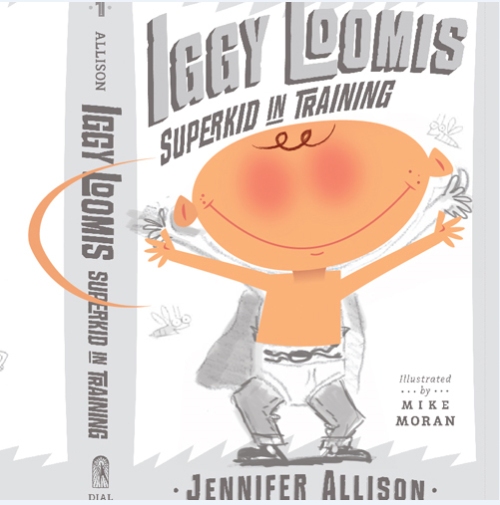
3) Other ways I do shading is with gradients. Sometimes I just make a fill color shape like the crescent on step 3 then lower the opacity.

4) I keep adding shapes together to form Iggy all on different layers. I place the eyes over the blurred circles. I work very hard on getting the eyes just right. I feel it’s the most important part. I add a brush stroke of the hair.
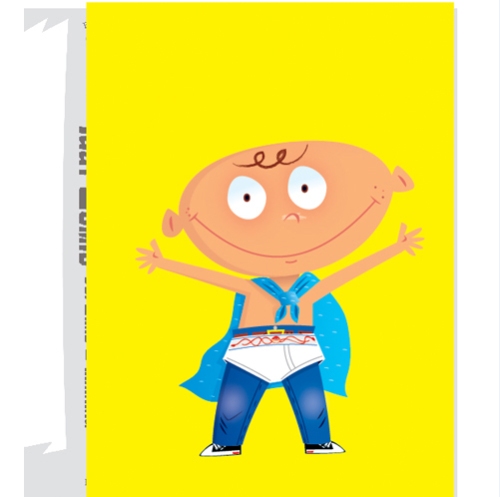
5) Iggy is completed! To give the knees on the jeans a worn out feeling I add white blurs.
The designer asked for a yellow background so I added that.

6) I wanted to give Iggy a little super hero glow around him so I added another blur.

7) I add some bees then I’m done working in illustrator. I export him in photoshop to keep all the layers.
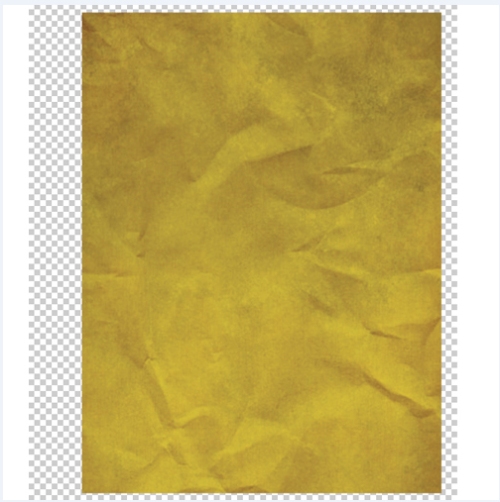
8) I take a texture of a brown paper bag. Place it over the layer with the yellow background. I lower the paper bag opacity to 70%.
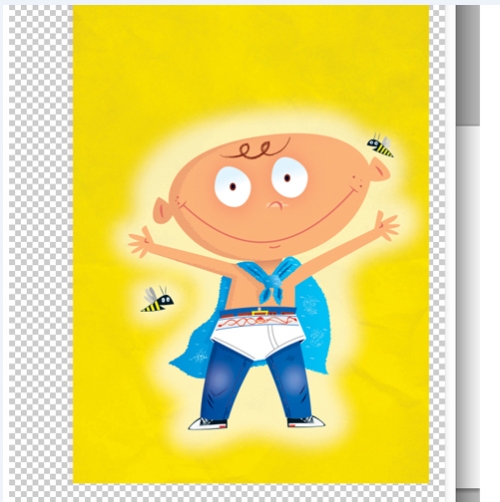
9) Using a textured brush I go along the blanket giving it a fuzzy look. Iggy is done and officially a superkid in training!
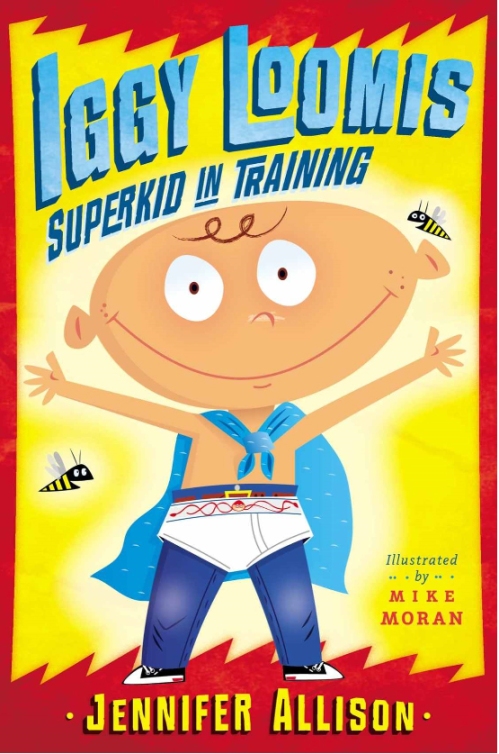
Here is the final cover.
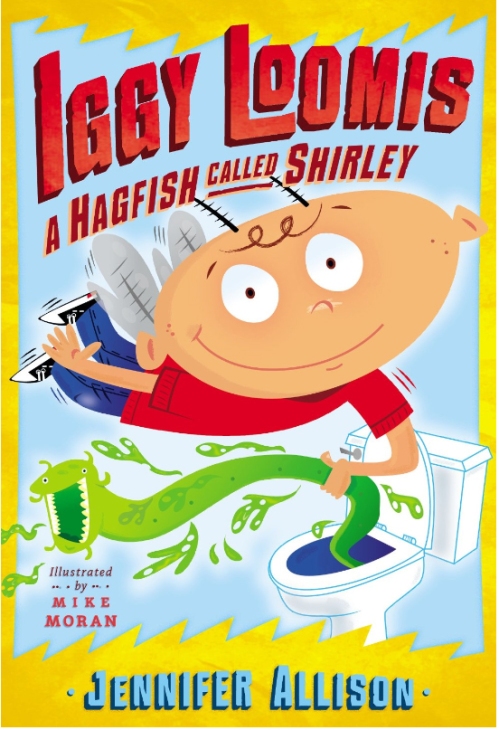
Another book over to the series.
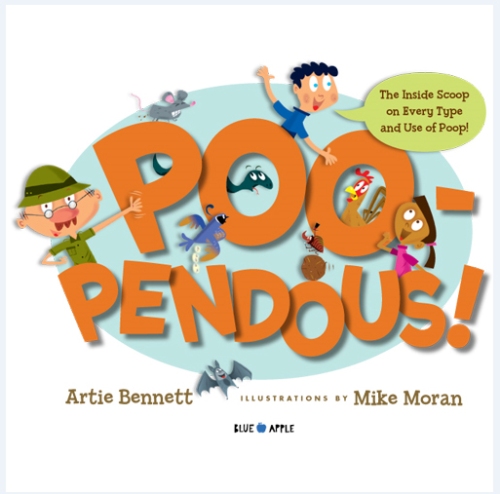
Interior cover art for POOPENDOUS.
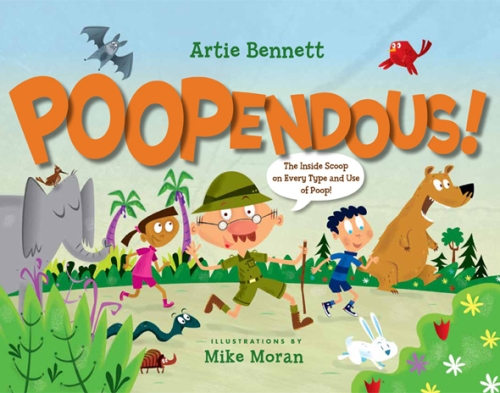
Cover art for POOPENDOUS
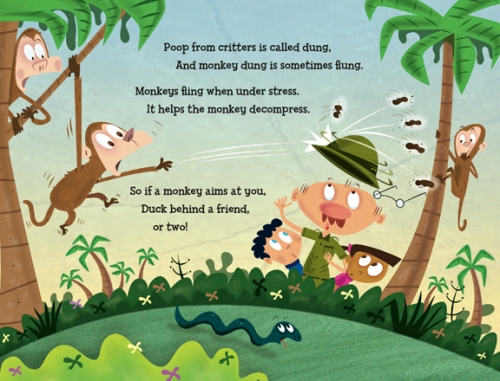
How long have you been interested in art?
I fell in love with drawing when I was just a kid. I learned from the best Hanna-Barbera. I spent many, many hours watching and drawing the Flintstones, The Jetsons and Top Cat. When I discovered Charlie Brown I would then create my own cartoon strips. Haven’t stopped!
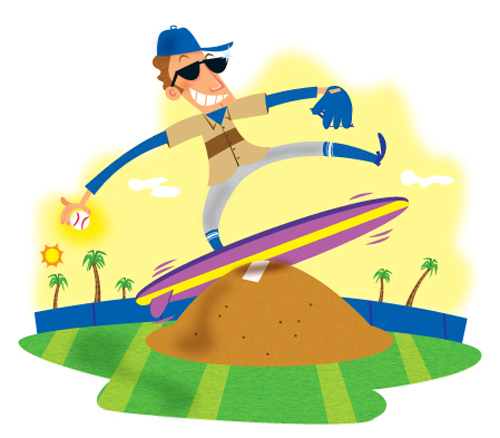
Did you study art in college? If so, what college did you attend and what did you study?
I went to community college for 2 years then transferred to the School of Visual Arts in NYC. That was a bit of an eye opener. Here I thought I was this really good artist and walked into SVA and was blown away with all the talent.
I majored in illustration I took a lot of life drawing classes, painting and illustration classes. I also took some graphic design, photography, printmaking plus all the other classes needed to get a BFA degree.

Can you tell us a little bit about the classes you liked?
One of my favorite classes was an illustration class taught by one of my
favorite teachers Marshall Arisman. In the class we would talk about past and present illustrators, the highs and lows of the business. He would always have a guest artist come in who was currently the hotshot illustrator of the NY Times at that moment.
One minute we would be talking about Thomas Nast then Ralph Steadman.
Marshall was a very fun, caring teacher and what a talent!

What was the first painting or illustration that you did for money?
My first paid job was a spot illustration for NJ Monthly magazine.
If I remember correct the article was about a statue of St. Patrick driving the snakes out of Ireland. I remember it took me forever to finish the illustration it had to be perfect because it was my first paying gig. I think I had over a week to finish it and I took every minute of that to do it.

What type of job did you do right after you graduated?
I paid my way through college working at a liquor store. When I graduated SVA I continued to work there. I would work the night shift and all weekends. During the day I would work on my portfolio or take it into NYC to show art directors. I also did some graphic design that I wasn’t crazy about. Working at the liquor store provided me with more time to work on my art and shop it around during the day.
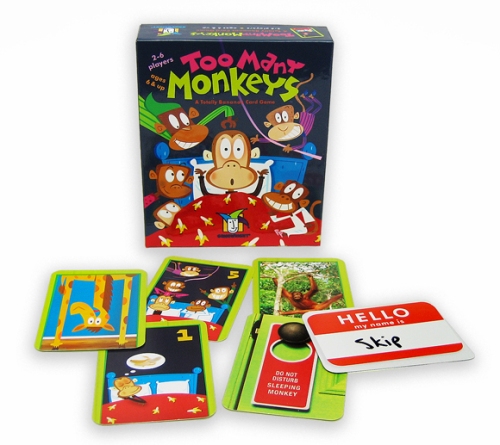
What do you think influenced your artistic style?
Top Cat! I just grew up a fan of cartoons. That’s how I geared my style.
That’s what makes me happy and I want to make people laugh and smile.

When did you do your the first illustration for children?
I don’t recall. I did a lot of work for Scholastic when I first started, good chance it was for them.

How did that come about?
When I first started out you could call up an art directors and make an appointment to show them your portfolio. There were also drop off days when you would drop your portfolio for review then pick it up the next day I’m sure that’s how I got my first illustration for children.

When did you decide you wanted to illustrate a children’s book?
I’ve always wanted to just illustrate. Books, toy packaging editorial, animation. I wanted to do it all, still do.
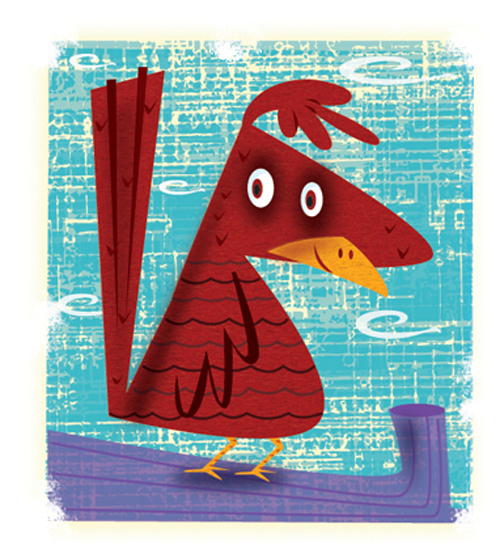
How long did it take you to get your first picture book contract?
I’m not sure how long it took. My first book fell in my lap.

What was your first book that you illustrated?
The Naturalist Handbook : Activities for Young Explorers for Gibbs Smith.

I see that you have done a number of Cloverleaf books, published by Millbrook Press. How many have you illustrated and how did the book contracts come your way?
I’ve done about 6 books for them. They came to me. I have them on my mailing list so it might have come through that. I worked with a few different editors there so I think they most likely saw the other books I did for them.

Are you open to illustrating a self-published book?
If you mean working with an author who is self publishing ,no. I like to deal with a publishing company. That way I know the story , design, text , printing are top noch. I want to represent myself the best way I can.
 How did you get the contract to illustrate Iggy Loomis, Superkid in Training?
How did you get the contract to illustrate Iggy Loomis, Superkid in Training?
Luck! I illustrated a Scholastic joke book for Marc Tyler Noble. He is friends with Jennifer Allison the author of Iggy Loomis . She asked him for an illustrator recommendation and it was me. I soon heard from the good folks over at Dial. Small world. I just finished up the art for the second Iggy Loomis book last week. We are hoping for good things!

Have you worked with educational publishers?
Sure have many ,many of them.

How many children’s books have you illustrated?
Give or take 15 ?
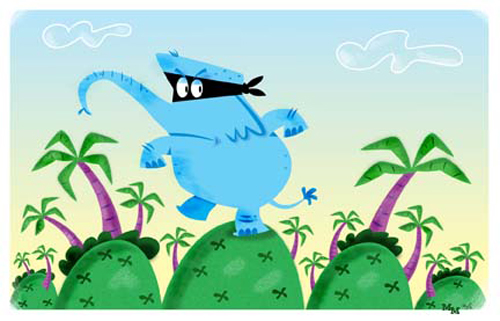
Do you have any desire to write and illustrate your own book?
I do. Right now I’m working on some ideas and have I have been pitching them to my agent. One idea I’m starting to flesh out right now. It’s exciting.

Have you done any illustrating for children’s magazines?
Oh, yea! I’ve had worked for many from the US to Canada. It’s really sad to see what was come to the world of magazines. There are a few hanging on and that’s a good thing that is happening.

Do you have an agent to represent you? If so how did you connect? If not, would you like one?
I am represented by Erica Silverman at Sterling Lord Literistic in NYC. I was introduced to her by Jennifer Alison the author of Iggy Loomis.
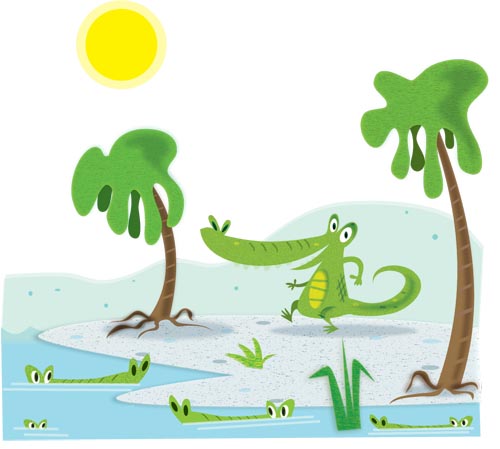
What types of things do you do to find illustration work?
I send out postcards with my own mailing list I keep. Networking, I’m on a few group websites. Lots of web exposer. I’ve gotten work through facebook that has turned into a monthly column for a magazine.

What is your favorite medium to use?
I’m in love with the computer! I’m a big fan of illustrator . More and more I’m loving working in photoshop. Can’t get enough of a marker and a sketchbook.

Has that changed over time?
Everything has changed. More and more companies have closed many art directors and editors losing jobs. I once did a lot of editorial work for major magazines and newspaper, its all changed. There are still open doors out there just not as many.

Do you have a studio in your house?
My studio is in the house. It nice to be home when my boys get come home. The hard thing is the studio is right in the house. It’s always hard for me not to go in there and do something. You feel like you are always on duty.

What is the one thing in your studio that you could not live without?
My computer and Adobe software.

Do you try to spend a specific amount of time working on your craft?
I’m always working on making my work better. The best is when I just sit down and work on my own personal work. I just recently had a solo gallery show at The Speakeasy Art Gallery in Boonton NJ. http://speakeasyart.wix.com/speakeasyart
Besides showing my digital work (some printed on bulletproof glass) I started making crazy wooden toys for the show. That was so much fun working with wood.
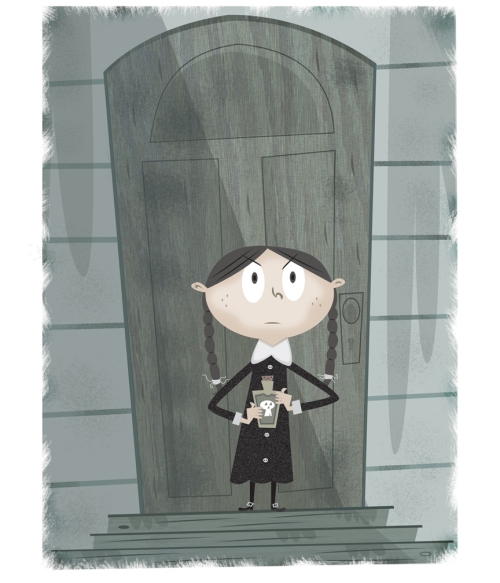
Do you take pictures or do any types of research before you start a project?
I don’t take reference pictures that much at all. Maybe if it’s a difficult angle of a hand. I do use the internet for research all the time. I illustrated a children’s book Poopendous by Artie Bennet for Blue Apple books. It’s a humorous/educational look at the use of poop. I had to research all kinds of animal dung. Fun!
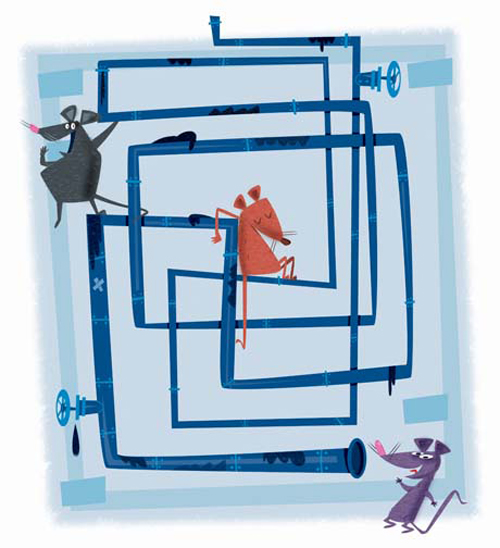
Do you think the Internet has opened doors for you?
Oh, yes the internet has opened many doors. For good or bad.
One good thing is now illustrators are reaching out to each other illustrators becoming friends and networking. You don’t feel alone as much locked alone in your studio all the time. Finding information is so much easier like names for your mailing list.
How about getting layouts sending in sketches and finals. Not like the days of faxing in sketches and using FedEx to send in the finals and hoping the art didn’t get bent.

Do you use Photoshop with your illustrations?
The majority of my work is done in illustrator then I export it into photoshop for textures .
 Do you own or have you used a Graphic Drawing Tablet in your illustrating?
Do you own or have you used a Graphic Drawing Tablet in your illustrating?
I have the largest Wacom Intuos that they made. It’s 24 x18 and the drawing area is 19×13. I can really move my arm around and it gives me the feeling like drawing on paper. Thinking about getting the Cintiq. I played with one in NYC a few months back. Photoshop felt great , illustrator felt a little clunky. I need to go back and play with it more.

What do you think is your biggest success thus far?
I’ve had many cool clients/jobs I have worked for over the years. One of my tops is that I illustrated the 2008 World Series and playoff programs, Phillies vs Rays. I’m a big baseball fan so that was a thrill. The programs go into the Baseball Hall of Fame so I joke that I’m in Cooperstown!
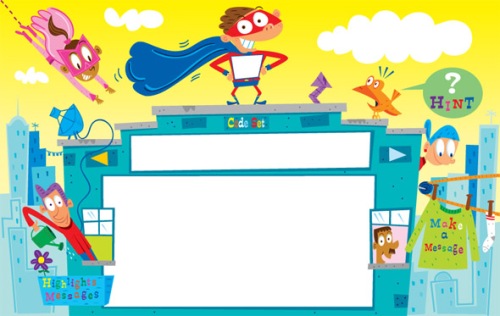
Do you have any career dreams that you want to fulfill?
Of course, getting a book that I wrote published would be fun. I love animation. Want to learn it better. I’ve pitched cartoons series in the past. Getting one of those would be amazing.

What are you working on now?
I just finished up the art for the second Iggy Loomis book last week, “Iggy Loomis and a Hagfish called Shirley”. Ever see a hagfish? They are disgusting!
Now I’m working on a series of ads for Disney Resorts, a few Highlights projects and I do a monthly cartoon strip for Boy’s Life Magazine.
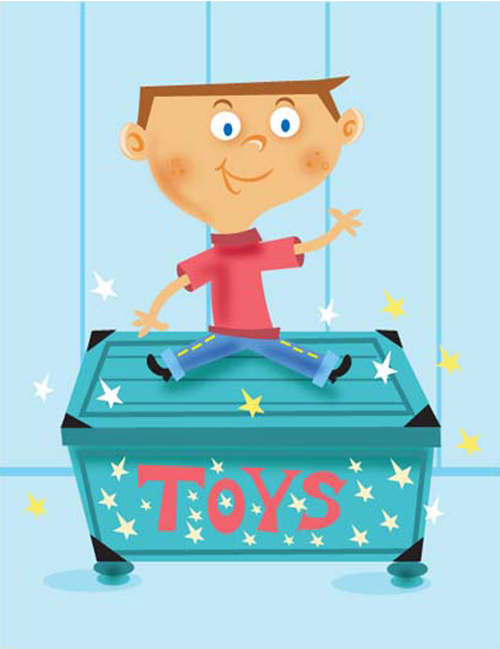
Do you have any material type tips you can share with us? Example: Paint or paper that you love – the best place to buy – a new product that you’ve tried – A how to tip, etc.
I use a great plug-in for illustrator called Xtream Path. It allows you to rag,stretch , push and pull the path. Here is the link http://www.cvalley.com/products/xtreampath/
For photoshop I’ve been using Kyle T Webster’s photoshop brushes.
Kyle is very talented, good guy and one of the hardest working illustrators out there. You will love his brushes. I’m having so much fun with them.
https://gumroad.com/kyletwebster

Any words of wisdom on how to become a successful writer or illustrator?
I think one important thing is to remember you are a business and have to act like one. Dealing with promotion, clients needs, deadlines, billing to contracts. There is much more then involved then just drawing pictures.

Mike, Thank you for sharing your illustrations, journey, and process with us this week. We look forward to following your career, so please let us know about your new books and all of your future successes.
You can see more of Mike’s work at : http://www.mikemoran.net
or on ChildrensIllustrators.com
Please take a minute to leave Mike a comment. I am sure he would love to hear from you and I would appreciate it, too. Thanks!
Talk tomorrow,
Kathy
11) The Naturalist Handbook : Activities for Young Explorers for Gibbs Smith.
Filed under:
Advice,
Illustrator's Saturday,
inspiration,
Process,
Tips Tagged:
Erica Silverman,
Iggy Loomis,
Lord Sterling Literistic in NYC,
Mike Moran,
Scholastic 

Let someone you invite to your network know how you came to find them or be referred to them. It can be as simple as, “I’m long time friends with so and so and I found your contact through her and think our connection here may be mutually beneficial.” Anything less than that is just creepy like the stock messages I’ve been getting on LinkedIn, “Please join my network.” My knee-jerk thinking is, “What do you think this is? Twitter or something? I don’t know you! I only talk to complete strangers on that social network.



 To run and race your best it’s critical you’ve got the right mindset. Dr. Jim Afremow has made it his mission to help runners and athletes of all sports hone their mental training. Just as important and the physical workouts, an athlete’s mind can create a champion or turn into one’s own worst enemy. I wanted interview Dr. Afremow both because I respect his body of work and level of expertise and also because, let’s be honest, the psychology of our sport in straight-up fascinating! Often time elite athletes have trouble putting into words exactly how they get into gamer mode…so read on to hear a mental game’s coach put words to the ability:
To run and race your best it’s critical you’ve got the right mindset. Dr. Jim Afremow has made it his mission to help runners and athletes of all sports hone their mental training. Just as important and the physical workouts, an athlete’s mind can create a champion or turn into one’s own worst enemy. I wanted interview Dr. Afremow both because I respect his body of work and level of expertise and also because, let’s be honest, the psychology of our sport in straight-up fascinating! Often time elite athletes have trouble putting into words exactly how they get into gamer mode…so read on to hear a mental game’s coach put words to the ability:
JIM AFREMOW, Ph.D.
1) What got you started in athletics, and what were your favorite sports growing up?
I grew up on sports and physical activity primarily through my father who appreciated the importance of having an active lifestyle. He especially enjoyed hiking, mountain climbing, and participating in Masters track and field. As a youth, my favorite sports included track and field, soccer, and golf.
2) How did you foray into becoming a mental games coach and working on the sports psychology end of the spectrum?
Sports psychology provides the perfect opportunity to bridge two of my passions: sports and psychology. I have always been fascinated by human behavior and how all of us can learn to reach our greatest potential. I earned a doctorate in sports psychology and a Master’s in counseling, both at Michigan State University.
3) You work with a variety of athletes in different sports, but in working with runners what are some of the most common mental hurdles they struggle with?
Mental toughness is equally import to physical strength when it comes to shining in sports. Adversity strikes all athletes in different ways at different times. Runners must learn how to stay focused and confidently move through any kind of setback, such as a mental block, performance plateau, prolonged slump, or injury. They must also develop ways to reduce off-field issues or concerns that interfere with their training and races.
4) Confidence is a big one with runners and racing, and confidence tends to ebb and flow, be it after bad workouts or ongoing injuries. What are some of the techniques you use to help runners rebuild and remain confident in themselves and their abilities?
Confidence is a beautiful thing! Confidence in yourself and your athletic ability is critical to performing your best when it matters most. One strategy for boosting your confidence is to remember a particular occasion when you triumphed over a difficult challenge and write about how you made it happen—memory is the prelude to memorable performances.
5) Race day nerves tends to be another big one, what are some of your suggestions for keeping your racing nerves in check?
First and foremost, understand that pre-performance anxiety is how our body readies itself to perform at its peak. So, recognize anxiety for what it is―that’s how humans are made. If you know that, it helps to normalize race day nerves. My new book The Champion’s Mind presents scores of practical tips to help you harness anxiety and use it to your advantage.
6) In running and in athletics in general what is something you feel is an especially crucial mental component in being your best, if not THE best?
Have a big-picture goal and chip away at each and every day. “When you’re good at something, make that everything,” said tennis legend Roger Federer. All it takes is all you’ve got!
7) What’s your favorite mental tip for runners to race and run their best?
During competition, the key word is “performance” because if you focus on performing (rather than on any results or other extraneous factors), then you’re totally in the present. Being in the present and staying purposeful lets you “own the moment” and maximize your abilities.
8) What was the greatest lesson or piece of advice you’ve been given either from a mentor, teacher, or athlete that you’ve applied to your work?
One important lesson is that we either win or we learn. Forget about losing and focus on continual improvement. Give yourself credit where credit is due and celebrate what you did well. But then if you didn’t do as well as you wanted, say, “What did I learn from this that’s going to help me perform better next time?”
9) Tell us about your book, your services, and your website?
The title of my new book is, “The Champion’s Mind: How Great Athletes Think, Train, and Thrive” (Rodale, 2014). The Champion’s Mind explains “what” athletes can do to champion themselves and “how” they can do it. That is, how athletes can fine-tune their game mentally and emotionally to consistently perform at their best. If you want to discover how great you can be and how much fun you can have in your sport, don’t leave the mental game to chance or circumstance.
So, I provide individual and team sports psychology services for personal excellence, peak performance, and team success. Although my private practice is located in Phoenix, I work with athletes from all over the world. Important topics include confidence, concentration, composure, communication, and commitment. All athletes can and should learn how to think like a champion. For more information, please visit my website: www.goldmedalmind.net.
10)Ultimately, what is your goal in being a sports performance specialist? What gives you the most sense of pleasure and fulfillment?
To help people reach their true and full potential in sports and all other demanding endeavors. To help people grow as athletes and as people. Champions think gold and never settle for silver or bronze. They understand that personal best is their ultimate victory. Why settle for anything less?

View Next 25 Posts
 Jersey Farm Scribe here on:
Jersey Farm Scribe here on:


 A few weeks ago, Agent Carly Watters on her blog talked about after you write a great manuscript, how does an agent decide to work with someone after that? She has seven tips.
A few weeks ago, Agent Carly Watters on her blog talked about after you write a great manuscript, how does an agent decide to work with someone after that? She has seven tips.


















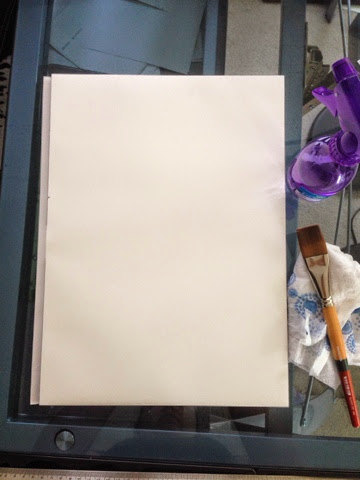


 Marcelo Elizalde was born in Buenos Aires, Argentina, in 1953. He is a self-taught, dedicated children’s books illustrator.
Marcelo Elizalde was born in Buenos Aires, Argentina, in 1953. He is a self-taught, dedicated children’s books illustrator.





















































 Rob McClurkan grew up in Nashville, Tennessee and spent many happy summers visiting his grandparents on their farms.
Rob McClurkan grew up in Nashville, Tennessee and spent many happy summers visiting his grandparents on their farms.

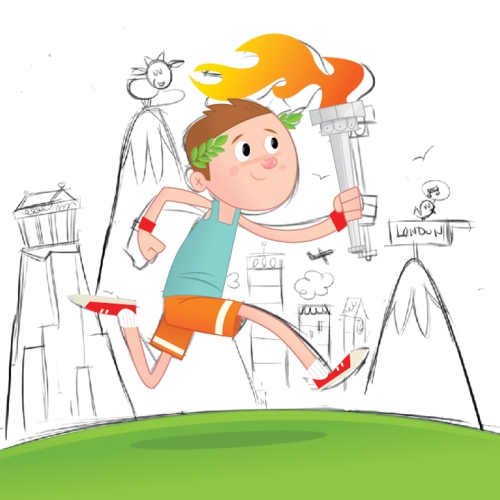












































 Mike Moran is a New Jersey based artist and children’s book illustrator. “Are We There Yet?” is a peek into his humorous world of zombies, down and out mice, sea creatures and more. His work is presented through a variety of mediums from wooden sculptures to prints on bullet-proof glass.
Mike Moran is a New Jersey based artist and children’s book illustrator. “Are We There Yet?” is a peek into his humorous world of zombies, down and out mice, sea creatures and more. His work is presented through a variety of mediums from wooden sculptures to prints on bullet-proof glass.

























 How did you get the contract to illustrate
How did you get the contract to illustrate 













 Do you own or have you used a Graphic Drawing Tablet in your illustrating?
Do you own or have you used a Graphic Drawing Tablet in your illustrating? 






 To run and race your best it’s critical you’ve got the right mindset. Dr. Jim Afremow has made it his mission to help runners and athletes of all sports hone their mental training. Just as important and the physical workouts, an athlete’s mind can create a champion or turn into one’s own worst enemy. I wanted interview Dr. Afremow both because I respect his body of work and level of expertise and also because, let’s be honest, the psychology of our sport in straight-up fascinating! Often time elite athletes have trouble putting into words exactly how they get into gamer mode…so read on to hear a mental game’s coach put words to the ability:
To run and race your best it’s critical you’ve got the right mindset. Dr. Jim Afremow has made it his mission to help runners and athletes of all sports hone their mental training. Just as important and the physical workouts, an athlete’s mind can create a champion or turn into one’s own worst enemy. I wanted interview Dr. Afremow both because I respect his body of work and level of expertise and also because, let’s be honest, the psychology of our sport in straight-up fascinating! Often time elite athletes have trouble putting into words exactly how they get into gamer mode…so read on to hear a mental game’s coach put words to the ability:
Erika, this was fantastic! I’ve never pursued a critique partner, largely because I’m not ready to do that and I’m not sure how well I would critique someone else’s work. I am very fortunate, though, to have several people in my life whose opinions I value and trust. They’ve helped me immeasurably, along with one specific professional critique by an editor. If I should ever be in the market for a critique partner or group, I will definitely keep all this in mind. Excellent advice. Thank you!
Thank you so much for your kind words. And I am so glad that it will be helpful to you someday. It’s great that you have those people in your life who you do use! Good luck!